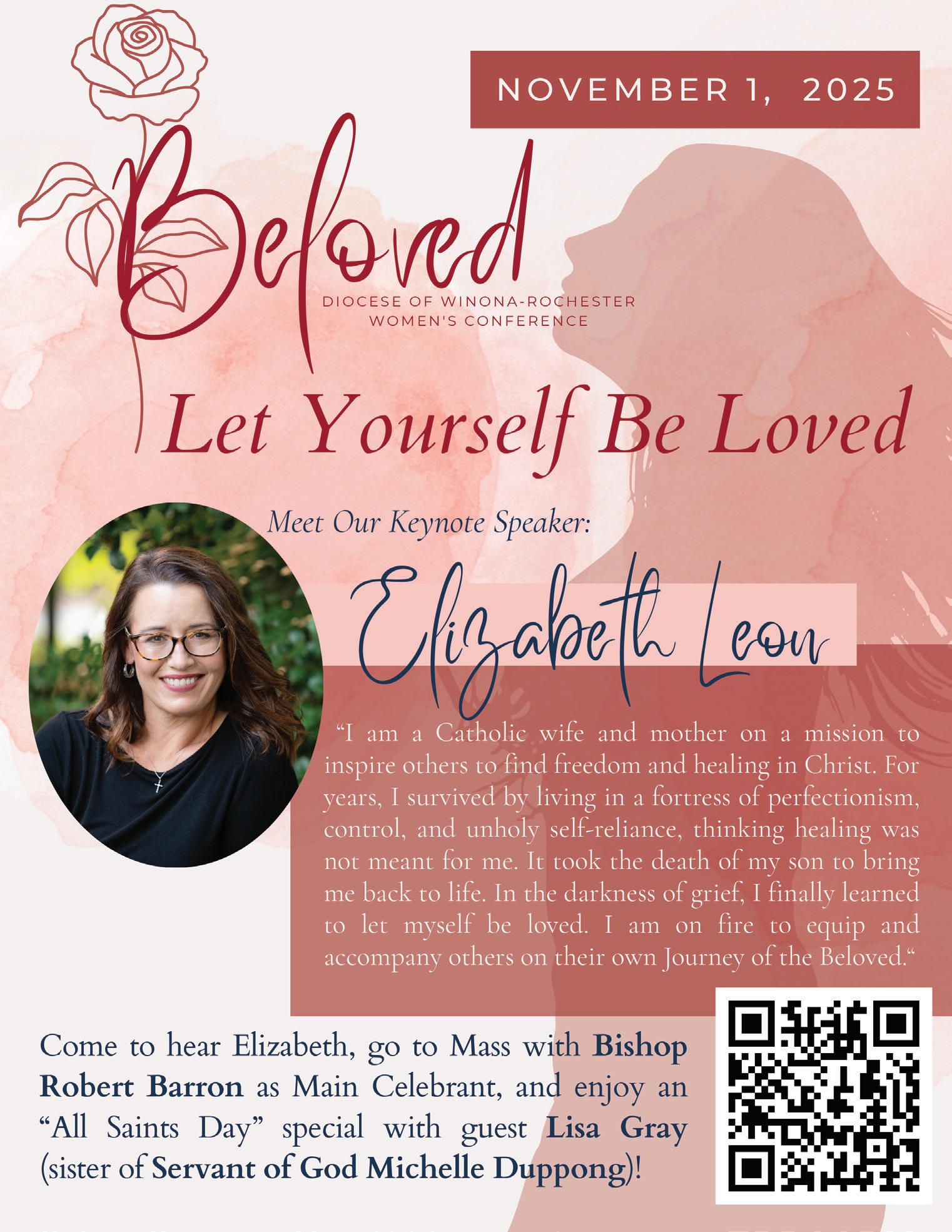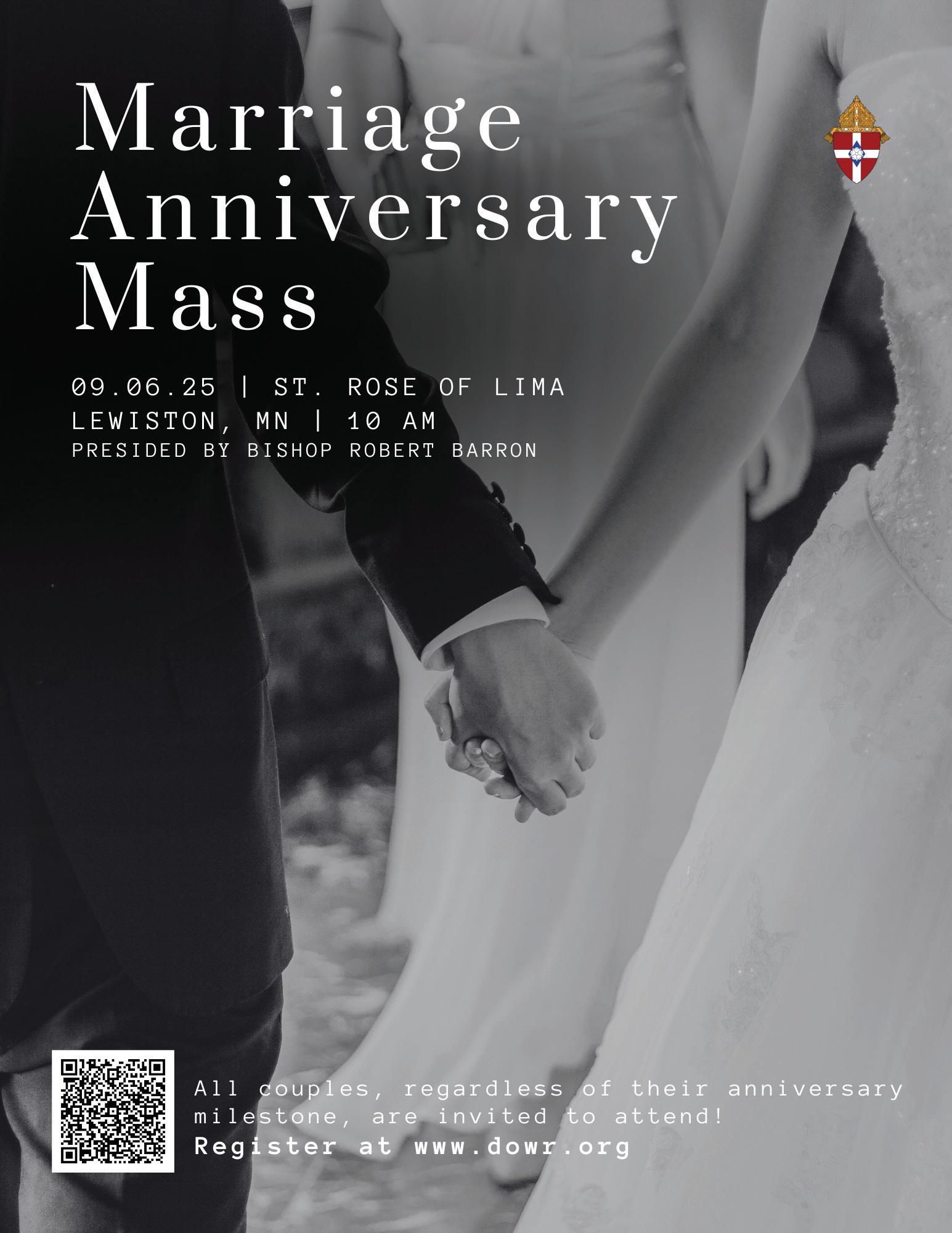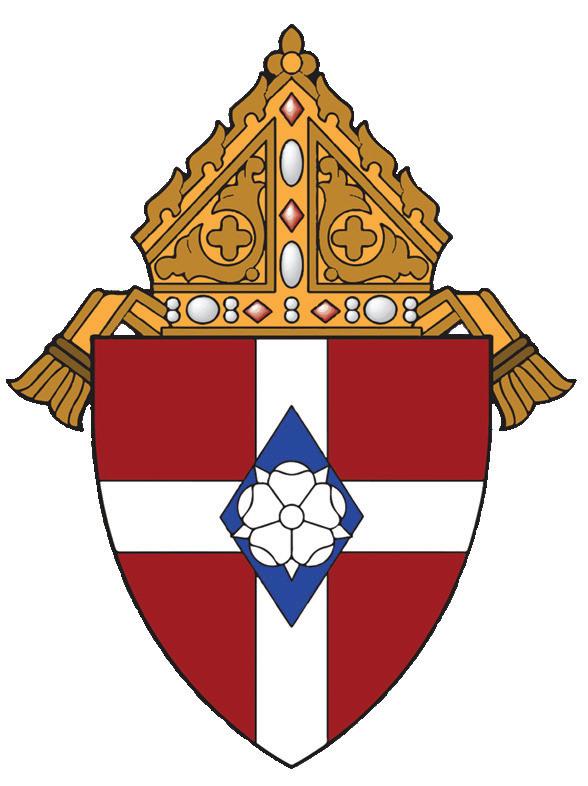

The COURIER
A Mission in ToTus Tuus
By NICOLE WENINGER
�his summer, many of the Immaculate Heart of Mary seminarians have been in various locations throughout the Diocese of WinonaRochestr spreading God’s love and teaching his word to youth at the summer program Totus Tuus (Latin for "Totally Yours").
According to Jacob Fiala of the Diocese of Winona-Rochester, he and his fellow missionaries teach the children through songs and games. During daily classes, they also get to teach them about the sacraments and the Joyful Mysteries of the Rosary.
He shares:
I could not be more grateful to have had this opportunity as a Totus Tuus missionary. The witness to the faith that the youth display greatly inspires me, giving me much hope for the future of the Church. Through their witness and God's abundant grace, I have fallen more in love with the priesthood and am truly living to be totally God's through the hands of our Blessed Mother.
Mateo Pascual of the Diocese of Peoria found this experience to be a profound step in his formation.
He stated:

Frequently Asked Questions About the Synod
By BRIAN KUSEK
What is a diocesan synod?
A diocesan synod is a gathering convened by the bishop to assist him in the governance of the diocese. By bringing together people with different backgrounds from across the local Church, the synod can aid the Bishop in identifying key priorities and initiatives to consider when setting a course for pastoral ministry. Put another way, it is an exercise of the bishop’s episcopal ministry meant to “promote acceptance of the Church’s salvific doctrine and to encourage the faithful in their following of Christ” (Instruction on Diocesan Synods, 1997, 3).
Why have a synod now?
While the Code of Canon Law suggests that a diocesan synod should be held regularly, the frequency varies based on the needs of particular dioceses. The first diocesan synod in the Diocese of Winona-Rochester was held in 1950, and we have not held one since. In the last ten years, we’ve seen a national downward trend in Mass attendance and priestly vocations. Bishop Barron is eager to resolve these crises in the local church by listening to the needs and desires of the people in his care.



Official Newspaper of the Roman Catholic Diocese of Winona-Rochester, MN | dowr.org
Synod, cont'd on pg. 6
Jacob Fiala, a DOW-R seminarian, in costume, engages children as a Totus Tuus missionary.
Totus Tuus, cont'd on pg. 6

Message of His Holiness Pope Leo XIV for the Upcoming 10th World Day of Prayer for the Care of Creation
From vatican.va June 30, 2025
�ear Brothers and Sisters!
The theme of this World Day of Prayer for the Care of Creation [September 1, 2025], chosen by our beloved Pope Francis, is “Seeds of Peace and Hope”. On the tenth anniversary of the establishment of this Day of Prayer, which coincided with the publication of the Encyclical Laudato Si’, we find ourselves celebrating the present Jubilee as “Pilgrims of Hope.” This year’s theme thus appears most timely.
In proclaiming the Kingdom of God, Jesus often used the image of the seed. As the time of his Passion drew near, he applied that image to himself, comparing himself to the grain of wheat that must die in order to bear fruit (cf. Jn 12:24). Seeds are buried in the earth, and there, to our wonder, life springs up, even in the most unexpected places, pointing to the promise of new beginnings. We can think, for example, of flowers springing up on our roadsides from seeds that landed there almost by chance. As those flowers grow, they brighten the gray tarmac and even manage to break through its hard surface.
In Christ, we too are seeds, and indeed, “seeds of peace and hope.” The prophet Isaiah tells us that the Spirit of God can make an arid and parched desert into a garden, a place of rest and serenity. In his words, “a spirit from on high will be poured out on us, and the wilderness will become a fruitful field, and the fruitful field a forest. Then justice will dwell in the wilderness, and righteousness abide in the fruitful field. The work of righteousness will be peace, and the work of righteousness, quietness and trust forever. My people will abide in a peaceful habitation, in secure dwellings, and in quiet resting places” (Is 32:15-18).
The Courier is the official publication of the Diocese of Winona-Rochester 2907 Jeremiah Lane NW, Rochester, MN, 55901 Vol 116 - 8
Most Reverend Robert E. Barron, Publisher Nick Reller, Associate Editor
Telephone: 507-361-3068 E-mail: nreller@dowr.org
Publishing Schedule: Monthly - Deadline for advertising & articles is the 10th of the month prior. (ISSN 0744-5490)
These words of the prophet will accompany the “Season of Creation,” an ecumenical initiative to be celebrated from 1 September to 4 October 2025. They remind us that, together with prayer, determination and concrete actions are necessary if this “caress of God” is to become visible to our world (cf. Laudato Si’, 84). The prophet contrasts justice and law with the desolation of the desert. His message is extraordinarily timely, given the evidence in various parts of the world that our earth is being ravaged. On all sides, injustice, violations of international law and the rights of peoples, grave inequalities and the greed that fuels them are spawning deforestation, pollution and the loss of biodiversity. Extreme natural phenomena caused by climate changes provoked by human activity are growing in intensity and frequency (cf. Laudato Deum, 5), to say nothing of the medium and long-term effects of the human and ecological devastation being wrought by armed conflicts.
As yet, we seem incapable of recognizing that the destruction of nature does not affect everyone in the same way. When justice and peace are trampled underfoot, those who are most hurt are the poor, the marginalized and the excluded. The suffering of indigenous communities is emblematic in this regard.
That is not all. Nature itself is reduced at times to a bargaining chip, a commodity to be bartered for economic or political gain. As a result, God’s creation turns into a battleground for the control of vital resources. We see this in agricultural areas and forests peppered with landmines, “scorched earth” policies, conflicts over water sources, and the unequal distribution of raw materials, which penalizes the poorer nations and undermines social stability itself.
Care of Creation, cont'd on pg. 5
Child Abuse Policy Information
• Hard copies are distributed at DOW-R parishes on the first or second weekend of each month.
• An online version may be viewed at www.dowr.org/offices/ courier/index.html
• To be added to the home delivery list free of charge, readers should send their names and addresses to:
Diocese of Winona-Rochester The Courier 2907 Jeremiah Lane NW Rochester, MN 55901 or nreller@dowr.org
The Diocese of Winona-Rochester will provide a prompt, appropriate and compassionate response to reporters of sexual abuse of a child by any diocesan agent (employees, volunteers, vendors, religious or clergy). Anyone wishing to make a report of an allegation of sexual abuse should call the Victim Assistance Coordinator at 507-454-2270, Extension 255. A caller will be asked to provide his or her name and telephone number. Individuals are also encouraged to take their reports directly to civil authorities. The Diocese of Winona-Rochester is committed to protecting children, young people and other vulnerable people in our schools, parishes and ministries. The diocesan policy is available on the diocesan web site at www.dow.org under the Safe Environment Program. If you have any questions about the Diocese of Winona-Rochester’s implementation of the Charter for the Protection of Children and Young People, please contact Michael Gerard at 507-361-3377, or mgerard@dowr.org.
Pope Leo XIV greets a child at the Cathedral of St. Pancras Martyr in Albano Laziale, southeast of Rome, Italy, July 20, 2025. (CNS photo / Vatican Media)
August Saint St. Maximilian Kolbe
Feast Day: August 14
From Catholic News Agency
�aint Maximilian Kolbe, the Polish Franciscan priest, missionary and martyr, is celebrated throughout the Church on August 14.
The saint died in the concentration camp at Auschwitz, during World War II, and is remembered as a “martyr of charity” for dying in place of another
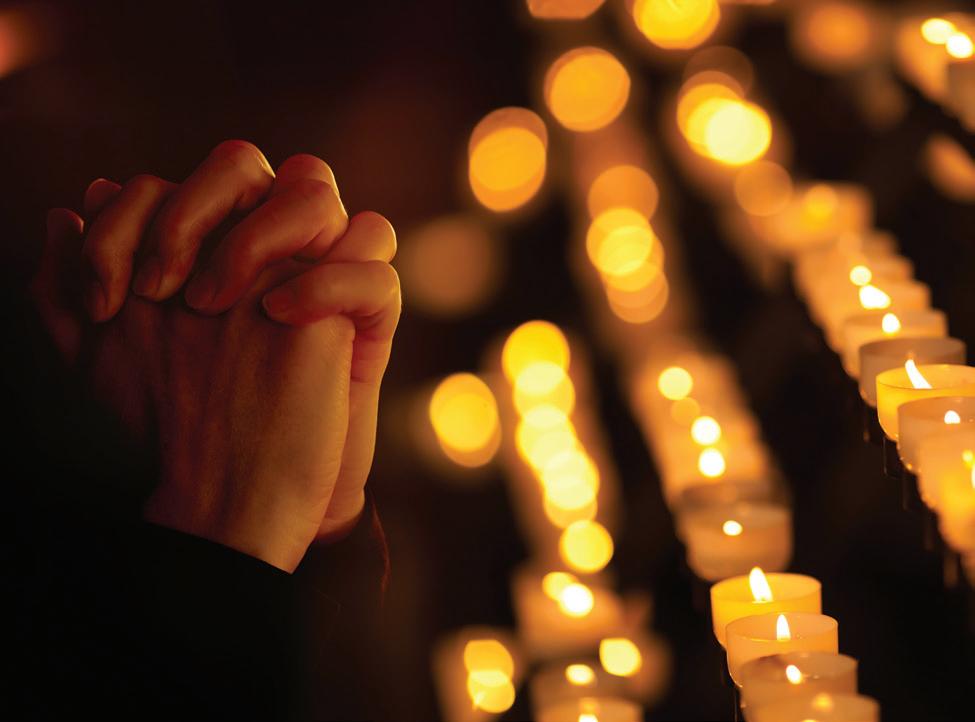
The Holy Father's Intention for August 2025
For Mutual Coexistence
Let us pray that societies where coexistence seems more difficult might not succumb to the temptation of confrontation for ethnic, political, religious, or ideological reasons.
prisoner who had a wife and children. He was canonized by Pope John Paul II on October 10, 1982.
St. Maximilian is also celebrated for his missionary work, his evangelistic use of modern means of communication, and for his lifelong devotion to the Virgin Mary under her title of the Immaculate Conception.
All these aspects of St. Maximilian's life converged in his founding of the Militia Immaculata. The worldwide organization continues St. Maximilian Kolbe's mission of bringing individuals and societies into the Catholic Church, through dedication to the Virgin Mary.
St. Maximilian, according to several biographies, was personally called by the Virgin Mary, both to his holy life and to his eventual martyrdom. As an impulsive and badly-behaved child, he prayed to her for guidance, and later described how she miraculously appeared to him holding two crowns: one was white, representing purity, the other red, for martyrdom.
When he was asked to choose between these two destinies, the troublesome child and future saint said he wanted both. Radically changed by the incident, he entered the minor seminary of the Conventual Franciscans at age 13, in 1907.
At age 20 he made his solemn vows as a Franciscan, earning a doctorate in philoso phy the next year. Soon after, however, he developed chronic tuberculosis, which eventually destroyed one of his lungs and weakened the other.
On October 16, 1917, in response to anti-Catholic demon strations by Italian Freemasons, Friar Maximilian led six other Franciscans in Rome to form the association they called the Militia Immaculata. The group's founding coincided almost exactly with the Bolshevik revolution in Russia, and the Marian appari tions at Fatima, Portugal.
As a Franciscan priest, Fr. Maximilian returned to work in Poland during the 1920s. There, he promoted the Catholic faith through newspapers and magazines which eventually reached an extraordinary circulation, published from a monastery so large it was called the “City of the Immaculata.”
In 1930 he moved to Japan, and had established a Japanese Catholic press by 1936, along with a similarly ambitious monastery.
That year, however, he returned to Poland for the last time. In 1939, Germany invaded Poland, and Fr. Kolbe was arrested. Briefly freed during 1940, he published one last issue of the Knight of the Immaculata before his final arrest and transportation to Auschwitz in 1941.
At the beginning of August that year, 10 prisoners were sentenced to death by starvation in punishment for another inmate's escape. Moved by one man's lamentation for his wife and children, Fr. Kolbe volunteered to die in his place.

Survivors of the camp testified that the starving prisoners could be heard praying and singing hymns, led by the priest who had volunteered for an agonizing death. After two weeks, on the night before the Church's feast of the Assumption of the Blessed Virgin Mary, the camp officials decided to hasten Fr. Kolbe's death, injecting him with carbolic acid.
St. Maximilian Kolbe's body was cremated by the camp officials on the feast of the Assumption. He had stated years earlier: “I would like to be reduced to ashes for the cause of the Immaculata, and may this dust be carried over the whole world, so that nothing would remain.”
This Month in The Courier Archives
& 75 Years

These are just some of the striking murals painted on the ceiling of St. Patrick's Church of West Albany, which celebrates its 125th anniversary this month.
[...]
The church is all that remains at the site of West Albany today, but it serves a vibrant parish community of about 125 families who can take pride in their colorful heritage.
Reprinted from August 2000.

Sacred Heart Parish Festival - Sunday, July 20th - a day clear, sunny, and cooler than many of its predecessors - was perfect in every way for the first summer festival at Sacred Heart parish in Adams. Hours of games and sales were highlighted by an antique-and-household-goods auction and the day culminated in an evening dance in teh school gym. This was a total parish effort, netting lots of fun, satisfaction, and nearly $7,000 for Sacred Heart school. When a parish wants to make something work - it does!
Reprinted from August 22, 1975.
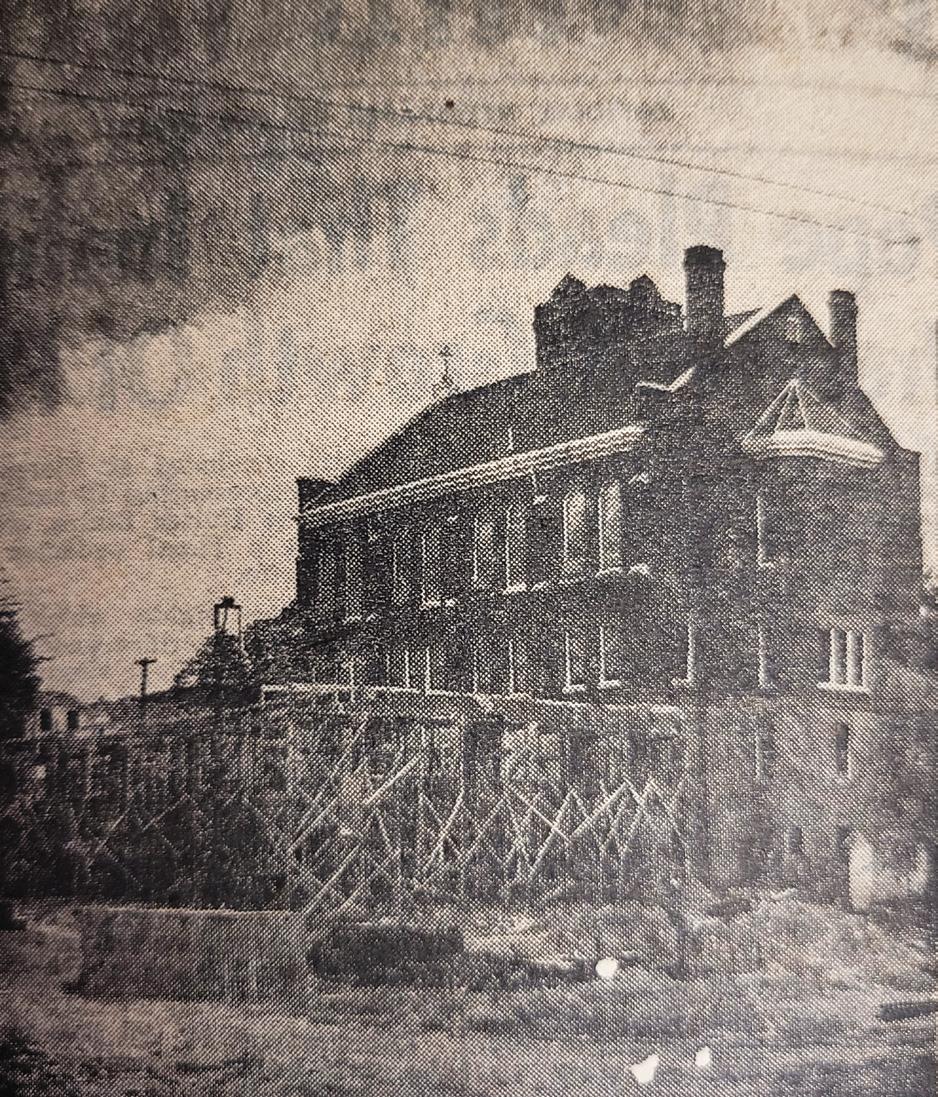
A new four-room grade school is being constructed for the St. Peter's parish at Hokah, Minn., and work is expected to be completed by next September. Cost of the project is estimated at $52,000. The new school will be located next to the church near highway 44. An addition to the convent also is being built.
Reprinted from August 13, 1950.
From the Bishop
� hen I was auxiliary bishop in Los Angeles some years ago, I spoke up at a meeting of the California hierarchy. We were considering a number of moves being made by the state legislature, including a proposal to require priests to break the seal of confession in matters dealing with child sex abuse.
I remember saying, “Brothers, I think we have to draw a line in the sand on this one.” And so we did. In every diocese and archdiocese of the state, the bishops roused their people to oppose this legislation. The good Catholics of California consequently flooded Sacramento with letters and petitions ardently defending Catholic prerogatives - and the legislators backed down.
It was a victory and an important one. However, similar laws have gone into effect in six other states and most recently the state of Washington legislated along the same lines, requiring
*indicates event is open to the public
August 6, Wednesday
5:30 p.m. - Equestrian Order of the Holy Sepulchre of Jerusalem Gathering - Co-Cathedral of St. John the Evangelist, Rochester
August 7, Thursday
*5 p.m. - Seminarian Candidacy Mass - St. Augustine, Austin
August 8, Friday
*8:30 a.m. - Staff Mass - The Chancery, Rochester
Officials
The Most Rev. Robert Barron, Bishop of the Diocese of Winona-Rochester, announces the following:
Review Board
Rev. Jason Kern: appointed to the Diocese of WinonaRochester Review Board, effective July 1, 2025, through the duration of time he serves as Rector of Immaculate Heart of Mary Seminary.
Drawing a Line in the Sand
priests to violate confidence, even as it exempts health care professionals from the same obligation. Happily, the bishops of Washington have filed suit to prevent the implementation of this law, and they have been joined by the Justice Department itself. I was very pleased to submit, with the help of the Thomas More Society, an amicus curiae letter in support of my brother bishops. As I said years ago in California, we have to draw a line in the sand.
No one doubts that the motivation behind these legislative moves is a deep and altogether legitimate concern for the safety of children. Catholics share this preoccupation. Indeed, beginning with the implementation of the Dallas accords of 2002, no institution in the world has done more to assure the protection of young people from sexual predation than the Catholic Church. Moreover, every bishop, priest, deacon, and lay minister is a mandated reporter, meaning that he or she is obligated by law to convey to the civil authorities any claim of the sexual abuse of a minor. Further, all of those leaders are required to follow, on a constant basis, training in regard to this issue. If you doubt my own dedication to eradicating the scourge of clerical sexual misbehavior,
August 10, Sunday
*10 a.m. - Pastor Installation Mass - St. John the Baptist, Mankato
August 12, Tuesday
*8:30 a.m. - Staff Mass - The Chancery, Rochester
August 14, Thursday
11 a.m. - Mass - St. Elizabeth Senior Living, Wabasha
August 15, Friday
Diocesan Teacher AssemblyLourdes High School, Rochester
Diaconal Ministry
Deacon John DeStazio: reappointed to diaconal ministry at St. Joachim Parish in Plainview and Immaculate Conception Parish in Kellogg, for a six-year term, effective July 1, 2025.
Senior Status
Deacon John Kluczny: granted Senior Deacon status, effective July 1, 2025.
take a look at my book Letter to a Suffering Church
However, the demand to report cannot be, for Catholics, absolute in the measure that it impinges upon the confidentiality of the confessional. Our belief is that in the sacrament of reconciliation, a penitent opens her heart to Christ himself and receives absolution, which is to say, healing at the level of the soul. What transpires in the privacy of the confessional is, from a spiritual standpoint, a matter of life and death. If there were, therefore, on the part of a prospective penitent, even the slightest suspicion that what he confesses might be shared publicly, he would not seek out this font of grace and the integrity of the sacrament would be utterly compromised. This is why, too, the breaking of the seal results in automatic excommunication of the priest in question. And this explains the awful dilemma currently presented to the priests of Washington state: either they break the seal of confession (and hence face excommunication) or they remain faithful to the sacrament (and hence face jail time). God knows that the Church has faced, over the centuries, more brutal persecution on the part of civil authority, but no Catholic priest in America should be subject to this sort of
August 16, Saturday
*4 p.m. - Pastor Installation
Mass - St. Pius X, Rochester
August 17, Sunday
*10 a.m. - Pastor Installation
Mass - St. Columban, Preston
August 19, Tuesday
3 p.m. - University Foundation Board Meeting - Zoom
August 21-22, ThursdayFriday
Diocesan Synod - Mankato
Social Concerns Committee
Ms. Lenore Fries: appointed to a one-year term on the Diocese of Winona-Rochester Social Concerns Committee, effective July 15, 2025.
Mr. John Grattan: appointed to a two-year term on the Diocese of Winona-Rochester Social Concerns Committee, effective July 15, 2025.
mistreatment. Permit me to doubledown on the properly American dimension of this question. The first amendment to the Constitution has two very important things to say about religion. The first relevant clause stipulates that “Congress shall make no law respecting an establishment of religion.” This means that the sort of arrangement that obtained in 18th century England between the government and the Church of England should not obtain in the United States. In other words, there should not be, in our country, any one religion that is specially favored or authorized by Congress. But the second relevant clause, less well-known, stipulates that Congress shall make no provision interfering with “the free exercise” of religion. Though no particular church can be institutionally favored, all churches should be free to express themselves in the public forum. Mind you, this goes beyond the mere permission to worship as one sees fit; it includes the exercise of one’s faith in the civic arena. And there is the rub. For all of these laws, which directly target the integrity of the confessional, are egregious violations of the free exercise clause. They militate against both a Catholic priest’s right to hear confessions as is
August 24, Sunday
*8 a.m. - 125th Parish Anniversary Mass - St. Agnes, Kellogg
August 26, Tuesday
11 a.m. - St. Paul Street
Evangelization - Rochester
2 p.m. - DOW-R Finance Council - The Chancery, Rochester
August 27, Wednesday 4 p.m. - Catholic Foundation of Southern Minnesota Board Meeting - The Chancery, Rochester
Ms. Delores Gutierrez: appointed to a one-year term on the Diocese of WinonaRochester Social Concerns Committee, effective July 15, 2025.
Ms. Sonia Smith: appointed to a two-year term on the Diocese of Winona-Rochester Social Concerns Committee, effective July 15, 2025.

appropriate and against a Catholic penitent’s right to participate in the sacrament without trepidation. So, Catholics should indeed rise up against this law of the state of Washington and those like it in other states, but I would insist that all loyal Americans should do so as well. For the moment, the state is threatening the Catholic Church, but if this is allowed to endure, what will prevent it from coming, in time, after the free exercise of other religions? Therefore, I say to my Catholic brothers and sisters, but also to all my fellow Americans, “don’t sit still, draw a line in the sand, fight back.”
*7 p.m. - Council of Nicaea Anniversary Event - Sts. Kosmas and Damianos Greek Orthodox Church, Rochester
August 28-30, ThursdaySaturday
Region VIII Bishops GatheringRapid City, SD
August 31, Sunday
*9:30 a.m. - Rector Installation
Mass - Co-Cathedral of St. John the Evangelist, Rochester
Loyola Catholic School
Ms. Michelle Schultz: appointed to a three-year term on the Loyola Catholic School Board of Trustees, effective July 15, 2025.
Bishop's Calendar
Non Nisi Te Domine
Bishop Robert Barron
Trazando una línea en la arena
Por el OBISPO ROBERT BARRON
�uando era obispo auxiliar en Los Ángeles hace algunos años, intervine en una reunión de la jerarquía de California. Estábamos considerando una serie de medidas que estaba tomando la legislatura estatal, entre ellas una propuesta para obligar a los sacerdotes a romper el secreto de confesión en asuntos relacionados con el abuso sexual de menores. Recuerdo haber dicho: «Hermanos, creo que tenemos que trazar una línea en la arena en este asunto». Y así lo hicimos. En todas las diócesis y arquidiócesis del estado, los obispos animaron a su pueblo a oponerse a esta legislación. En consecuencia, los buenos católicos de California inundaron Sacramento con cartas y peticiones en las que defendían ardientemente las prerrogativas católicas, y los legisladores dieron marcha atrás.
Fue una victoria importante. Sin embargo, leyes similares han entrado en vigor en otros seis estados y, más recientemente, el estado de Washington ha legislado en la misma línea, exigiendo a los sacerdotes que violen la confidencialidad, aunque exime a los profesionales de la salud de la misma obligación. Afortunadamente, los obispos de Washington han presentado una demanda para impedir la aplicación de esta ley, y se les ha sumado el propio Departamento de Justicia. Me complació mucho presentar, con la ayuda de la Thomas More Society,
una carta amicus curiae en apoyo de mis hermanos obispos. Como dije hace años en California, tenemos que marcar un límite.
Nadie duda de que la motivación detrás de estas medidas legislativas es una preocupación profunda y totalmente legítima por la seguridad de los niños. Los católicos compartimos esta preocupación. De hecho, desde la aplicación de los acuerdos de Dallas de 2002, ninguna institución en el mundo ha hecho más por garantizar la protección de los jóvenes contra los abusos sexuales que la Iglesia católica. Además, todos los obispos, sacerdotes, diáconos y ministros laicos son informantes obligatorios, lo que significa que están obligados por ley a comunicar a las autoridades civiles cualquier denuncia de abuso sexual de un menor. Además, todos esos líderes están obligados a seguir, de forma constante, una formación sobre este tema. Si dudan de mi dedicación a erradicar el flagelo de la conducta sexual inapropiada del clero, echen un vistazo a mi libro Carta a una Iglesia que sufre Sin embargo, la obligación de denunciar no puede ser, para los católicos, absoluta en la medida en que afecta a la confidencialidad de la confesión. Creemos que, en el sacramento de la reconciliación, el penitente abre su corazón al mismo Cristo y recibe la absolución, es decir, la curación del alma. Lo que ocurre en la intimidad del confesionario es, desde un punto de
Care of Creation,
cont'd from pg. 2
These various wounds are the effect of sin. This is surely not what God had in mind when he entrusted the earth to the men and women whom he created in his image (cf. Gen 1:24-29). The Bible provides no justification for us to exercise “tyranny over creation” (Laudato Si’, 200). On the contrary, “the biblical texts are to be read in their context, with an appropriate hermeneutic, recognizing that they tell us to ‘till and keep’ the garden of the world [cf. Gen 2:15]. ‘Tilling’ refers to cultivating, ploughing or working, while ‘keeping’ means caring, protecting, overseeing and preserving. This implies a relationship of mutual responsibility between human beings and nature” (ibid., 67).
Environmental justice – implicitly proclaimed by the prophets – can no longer be regarded as an abstract concept or a distant goal. It is an urgent need that involves much more than simply protecting the environment. For it is a matter of justice – social, economic and human. For believers it is also a duty born of faith, since the universe reflects the face of Jesus Christ, in whom all things were created and redeemed. In a world where the most vulnerable of our brothers and sisters are the first to suffer the devastating effects of climate change, deforestation and pollution, care for creation becomes an expression of our faith and humanity.
vista espiritual, una cuestión de vida o muerte. Por lo tanto, si por parte de un posible penitente existiera la más mínima sospecha de que lo que confiesa pudiera ser compartido públicamente, no buscaría esta fuente de gracia y la integridad del sacramento se vería totalmente comprometida. Por eso, además, la ruptura del secreto confesional da lugar a la excomunión automática del sacerdote en cuestión. Y esto explica el terrible dilema al que se enfrentan actualmente los sacerdotes del estado de Washington: o rompen el secreto de confesión (y se enfrentan a la excomunión) o permanecen fieles al sacramento (y se enfrentan a penas de cárcel). Dios sabe que la Iglesia ha sufrido, a lo largo de los siglos, persecuciones más brutales por parte de la autoridad civil, pero ningún sacerdote católico en Estados Unidos debería ser objeto de este tipo de maltrato. Permítanme insistir en la dimensión propiamente estadounidense de esta cuestión. La primera enmienda de la Constitución contiene dos disposiciones muy importantes sobre la religión. La primera cláusula relevante estipula que «el Congreso no aprobará ninguna ley que establezca una religión oficial». Esto significa que el tipo de acuerdo que existía en la Inglaterra del siglo XVIII entre el Gobierno y la Iglesia de Inglaterra no debe existir en los Estados Unidos. En otras palabras, en nuestro país no debe haber ninguna religión que sea especialmente favore-
Now is the time to follow words with deeds. “Living our vocation to be protectors of God’s handiwork is essential to a life of virtue; it is not an optional or a secondary aspect of our Christian experience” (Laudato Si’, 217). By working with love and perseverance, we can sow many seeds of justice and thus contribute to the growth of peace and the renewal of hope. It may well take years for this plant to bear its first fruits, years that, for their part, involve an entire ecosystem made up of continuity, fidelity, cooperation and love, especially if that love mirrors the Lord’s own self-sacrificing Love.
Among the Church’s initiatives that are like seeds sown in this field, I would mention the Borgo Laudato Si’ project that Pope Francis bequeathed to us at Castel Gandolfo. It is a seed that promises to bear fruits of justice and peace, and an educational project in integral ecology that can serve as an example of how people can live, work and build community by applying the principles of the Encyclical Laudato Si’
I pray that Almighty God will send us in abundance his “Spirit from on high” (Is 32:15), so that these seeds, and others like them, may bring forth an abundant harvest of peace and hope.
The Encyclical Laudato Si’ has now guided the Catholic Church and many people of good will for ten years. May it continue to inspire us and may integral ecology be increasingly accepted as the right path to follow. In this way, seeds of hope will multiply, to be “tilled and kept” by the grace of our great and unfailing Hope, who is the risen Christ. In his name, I offer all of you my blessing.
cida o autorizada por el Congreso. Pero la segunda cláusula relevante, menos conocida, estipula que el Congreso no promulgará ninguna ley que interfiera con «el libre ejercicio» de la religión. Aunque ninguna iglesia en particular puede ser favorecida institucionalmente, todas las iglesias deben ser libres de expresarse en el foro público. Atención: esto va más allá del mero permiso para practicar el culto como uno considere oportuno; incluye el ejercicio de la fe en la esfera cívica. Y ahí está el problema. Todas estas leyes, que apuntan directamente a la integridad del confesionario, son violaciones flagrantes de la cláusula de libre ejercicio. Van en contra tanto del derecho de un sacerdote católico a escuchar confesiones como corresponde como del derecho de un penitente católico a participar en el sacramento sin temor.
Por lo tanto, los católicos deben levantarse contra esta ley del estado de Washington y otras similares en otros estados, pero insisto en que todos los estadounidenses leales también deben hacerlo. Por el momento, el estado está amenazando a la Iglesia católica, pero si se permite que esto continúe, ¿qué impedirá que, con el tiempo, se ataque el libre ejercicio de otras religiones? Por lo tanto, les digo a mis hermanos y hermanas católicos, pero también a todos mis compatriotas estadounidenses: «No se queden quietos, tracen una línea en la arena, luchen».

Totus Tuus,
This experience has been one of the greatest blessings of my formation thus far... In the midst of giving talks, teaching the catechism, and leading prayer, God was doing something in me - quietly, patiently forming my heart into the spiritual father He’s calling me to be… Totus Tuus taught me how to love with more freedom, to give of myself even when I feel empty, and to trust that the Holy Spirit always guides me, especially when I feel tired. The grace I’ve received didn’t come in flashes of lightning, but in the smiles of children, the quiet moments before the Blessed Sacrament, and the little reminders that God is faithful.
Synod, cont'd from pg. 1
How does the diocesan synod differ from the Synod on Synodality?
Both the Universal Synod called by Pope Francis in 2020 and the Diocesan one are “synods” in the same sense. That is, both are deliberative bodies organized to assist particular shepherds with the pastoral care of the Church. However, each has a different scope, different members, and different emphases. The synod directed by Bishop Barron will focus exclusively on the direction of the Diocese of Winona-Rochester in regards to evangelization and priestly vocations.
What sorts of questions are being addressed?
The preparatory phase of the diocesan synod has brought forward plenty of actionable steps that we can take as a diocese to double the number of vocations and to double the number of people in the pews. The general themes of suggestions address everything from leveraging the power of beauty, practicing hospitality, and strengthening catechesis. The synod is not concerned with changing Church teaching, but developing a concrete plan to bolster vocational and evangelical efforts in our diocese.
What happens at the Synod Assembly?
At the assembly, or synod proper, the themes and proposals gathered from our regional discussions, reviewed by the committee and approved by Bishop Barron, will be presented for discussion. Ex officio (assigned because of the position they hold) and elected representatives will pray, deliberate, and present resolutions based on the themes and proposals that were brought forth.
“Once the synodal sessions shall have concluded, the diocesan Bishop will proceed to the final drafting of the synodal decrees and declarations. He signs them and he orders their publication” (Instruction, V. I). Having listened to the faithful and synod members, Bishop Barron will prayerfully consider the conclusions and requests proposed by the synod assembly before making his decisions about a pastoral plan related to evangelization and priestly vocations. All input will be considered but the bishop has
We are so proud of the hard work our seminarians have put in this summer. We ask that you continue to pray for them as they complete their missions for this season.
Nicole Weninger is a marketing and communications associate for the Catholic Foundation of Southern Minnesota.


Prayer for the Diocesan Synod
Most High and Gracious God,
We implore you for the outpouring of the Holy Spirit on the Diocese of Winona-Rochester as we embark on the Diocesan Synod for Evangelization and Vocations.
We ask You to send us graces for wisdom and insight into how we can proclaim the Gospel and invite your sons and daughters into a right relationship of worship and friendship through Your Son Jesus Christ.
As we seek your grace to make you known and loved, we also beg you for the grace to invite each member of our Diocese to serve you with the gift of their lives in service to the Church especially in more vocations to the Priesthood and Consecrated Life.
Give us the gift of your Spirit for right discernment and clarity of approach so that we might faithfully carry out Your will in this Diocese and in each of our parishes. We pray in gratitude for every gift and blessing You bestow and put our full confidence in Your holy will.
Through our Lord Jesus Christ, in union with the Father and the Holy Spirit, God forever and ever.
Amen.
the ultimate say in what will be decreed. “The Synod is thus contextually and inseparably an action of episcopal governance and an event of communion, thus expressing that nature of hierarchical communion which belongs to the profound nature of the Church” (Instruction, I.1).
What role do I play?
Our diocesan synod will be celebrated this August on the Feast of the Queenship of Mary. Bishop Barron, alongside our vicars, priests, deacons, religious, theologians, and elected parish representatives, will
gather for this pivotal moment in our diocesan life. While participation in the synod sessions is limited to select delegates, all are warmly invited to join the public liturgies that will open and close the Synod on August 21 and 22 at Ss. Peter & Paul in Mankato. Most importantly, everyone is invited to pray for this synod throughout the summer. Through the intercession of Mary, Queen of the New Evangelization and Mother of Priests, may our efforts yield abundant fruit and usher in a new era of growth, vitality, and fidelity in the Diocese of Winona-Rochester. Brian Kusek is the director of evangelization for the Diocese of Winona-Rochester.
Mateo Pascual, an IHM seminarian for the Diocese of Peoria, poses as a human sundae.
The Fire We Possess 7
By OLIVIA ANDERSON
�
reetings! My name is Olivia Anderson. I’m 20 years old, and I’m from Blooming Prairie. The past two years I had the opportunity to serve as a missionary with NET ministries, which is an acronym for National Evangelization Teams. The mission statement for NET is: “We challenge young Catholics to follow Christ and embrace a life of community in the Church.”
As a NET missionary, I learned a lot about myself, God, and how youth receive the Gospel. My heart was set on fire for Jesus and the desire to bring his children closer to his Most Sacred Heart, so their hearts may be on fire for him.
Since my missionary years in Indianapolis, IN, and Newaygo, MI, God has also given me a passion for helping set my parish, community, and diocese on fire for the Lord. I pray that God may use me, and that he may speak and inspire through this article.
The Diocese of Winona-Rochester is in a time of revival with the Diocesan Synod on Evangelization and Vocations underway. It is for this reason that I would like to share my perspective on evangelization.
There are many signs that a youth ministry program may need re-evaluating. One sign is having youth thinking faith formation or catechism classes feel like the boring, required classes at school. If youth think this about learning the faith, then Mass will feel like the homework, and Confirmation like graduation. If this becomes acceptable, then it should come as no surprise when young people stop attending Mass and begin leaving the Church.
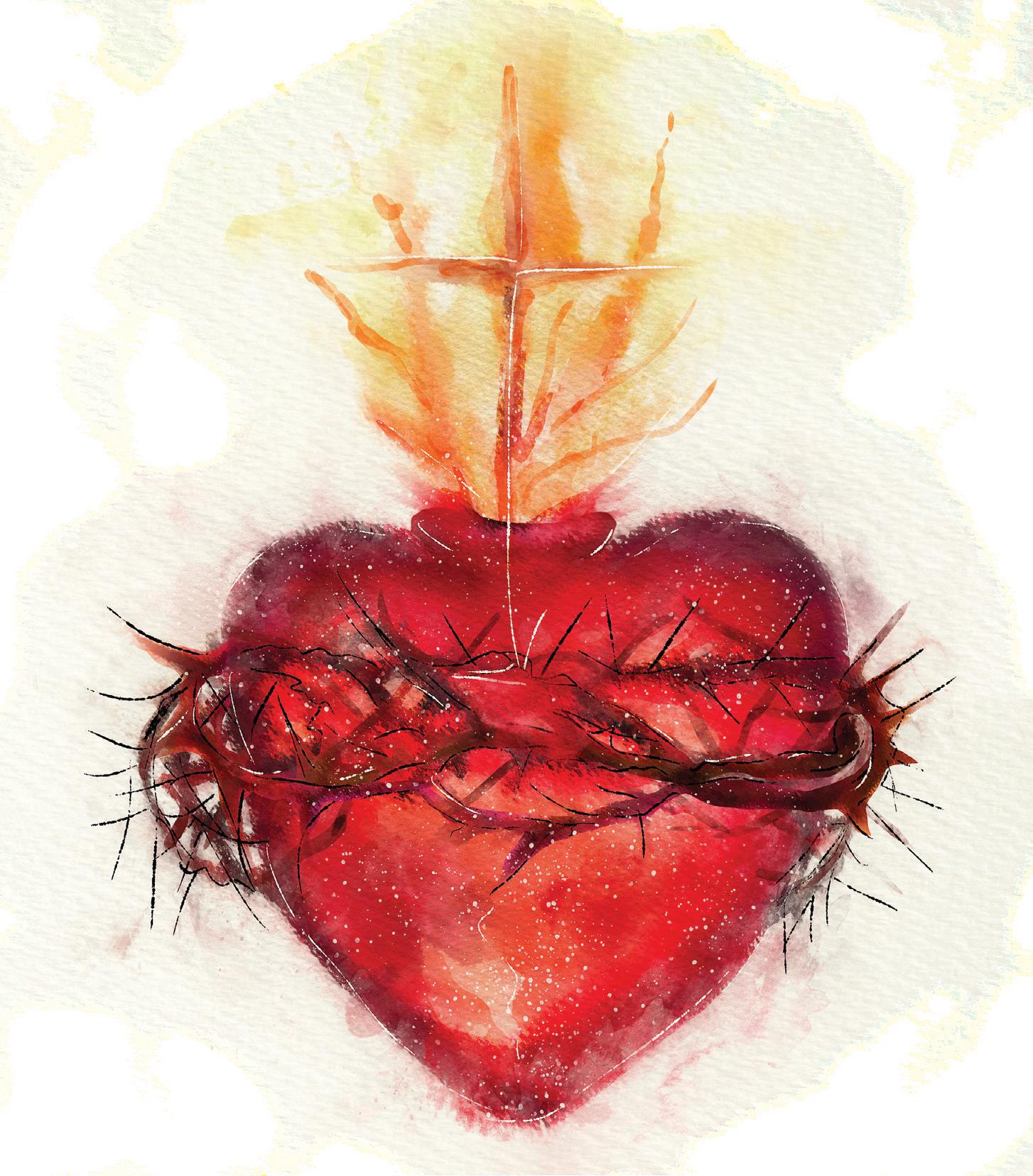
I witnessed Element 2 executed beautifully through many signs during the nine months I spent at the Catholic parishes in Newaygo County, Michigan. The first sign was at every Sunday Mass the pews were usually so full I had to often squeeze in. Not only were their churches packed, but the number of young people grew every Mass. The second sign I noted: youth ministry wasn’t just a focus for the catechists, but was a priority for everyone in the community. It was evident that the parishes and every person we encountered sacrificed a lot of money and time to bring our NET discipleship team to their community for nine months. The priests, youth minister, and other adults, believed if the young people were given an opportunity to have young adults accompany them on their faith journey, they may begin to open their hearts to God’s burning love for them. I was blessed to serve these parishes, and I believe that it was equally us missionaries and the faith community there who partnered to lead the youth closer to God.
Without personal testimonies and relatability, the Bible becomes a book of irrelevant old stories, and the Church teachings feel like a set of unreasonable and strict rules. We can’t force young people to care about faith, and we definitely can’t expect them to be on fire for something they don’t see ignited in their peers or role models. If youth don’t see other Catholics caring about a personal relationship with Jesus, then they won’t feel a need to continue to pursue their own faith. Young people need something they see as worth their time, so if they see actions, like attending Mass, but don’t understand the love and personal relationship with Jesus, they will likely leave the Church. “If I speak in the tongues of men or of angels, but do not have love, I am only a resounding gong or a clanging cymbal. If I have the gift of prophecy and can fathom all mysteries and all knowledge, and if I have a faith that can move mountains, but do not have love, I am nothing. If I give all I possess to the poor and give over my body to hardship that I may boast, but do not have love, I gain nothing” (1 Corinthians 13: 1-3).
Although there are a variety of reasons for struggles in youth ministry, I’d like to offer a positive perspective obtained from my time in faith formation classes, and over the past two years of youth ministry with NET. It isn’t difficult to see how extremely hard it is to be a young Catholic in today’s culture, without proper guidance from the Church. We know, deep down, young people are starving for the truth, and they can’t feed themselves. They need faith mentors who can guide them closer to Christ, and help them in their faith journey. As a church, as a diocese, as a parish, and individually, each of us must kindle the fire that burns for Jesus.
Through my experiences leading diverse groups of youth, there have been two main elements present which make up a fruitful method for leading youth in discipleship. Element 1: people with hearts burning for Christ will be the most effective mentors to lead young people to him. Element 2: when youth possess this fire for God, the fire must be kindled or it will be extinguished. How these elements are incorporated in youth ministry leads to either forming lifelong disciples or causing youth to leave the Church. It is for this reason youth faith formation and discipleship cannot be overlooked, as it affects the life of the whole diocese and the future of the entire Catholic Church.
Let’s break down Element 1: people with hearts burning for Christ will be the most effective way to lead young people to him. When it comes to sharing the faith with youth, testimony should be prioritized.
St. Pope Paul VI said, “Modern man listens more willingly to witnesses than to teachers, and if he does listen to teachers, it is because they are witnesses.” This is true for my own faith story, as the witnesses in my life changed my view of Jesus. Jesus went from someone judging me from heaven who I would eventually meet when I die, to someone inviting me into a relationship with him every day. I honestly don’t believe I would be a practicing Catholic without these witnesses showing me how Christ is active in our daily lives. Focusing on how Christ has worked, and continues to work, in our lives is the key that may begin to unlock the heart of a young person. It is also necessary to explain how the Bible and Church teachings are always relevant and affect our lives still today.
The Catechism of the Catholic Church says “The purpose of life is to know God and to love him and serve him.” (cc: 1, 68) But, really, who wants to love or serve someone they don’t know? Sharing personal testimonies and how scripture and Church teachings are relatable are vital to this first element of effective youth faith formation.
Another sign of Element 2 was the weekly youth group gatherings, which provided opportunities for community, prayer, sacraments, and service. I saw that, through having this solid community to grow together, youth would naturally continue to pursue deeper relationship with Jesus Christ. With this personal growth came a desire to bring their friends to youth group and closer to Jesus. Both elements of effective youth discipleship method are in harmony when providing youth with a fun and growth-oriented community led by adults joyfully living out discipleship.
The elements of effective youth discipleship are crucial. It is solely through abiding in Jesus’ Most Sacred Heart that our hearts, too, may be ignited with a sacred flame of love; these hearts burn for souls to be united to Christ, thus joyfully spreading this powerful flame to others like wildfire. It is our nurturing of the fire we possess that affects the flame of our entire diocese and the Catholic Church.
Trusting in your mercy, I walk through life like a little child, offering you each day this heart burning with love for your greater glory.
- St. Faustina
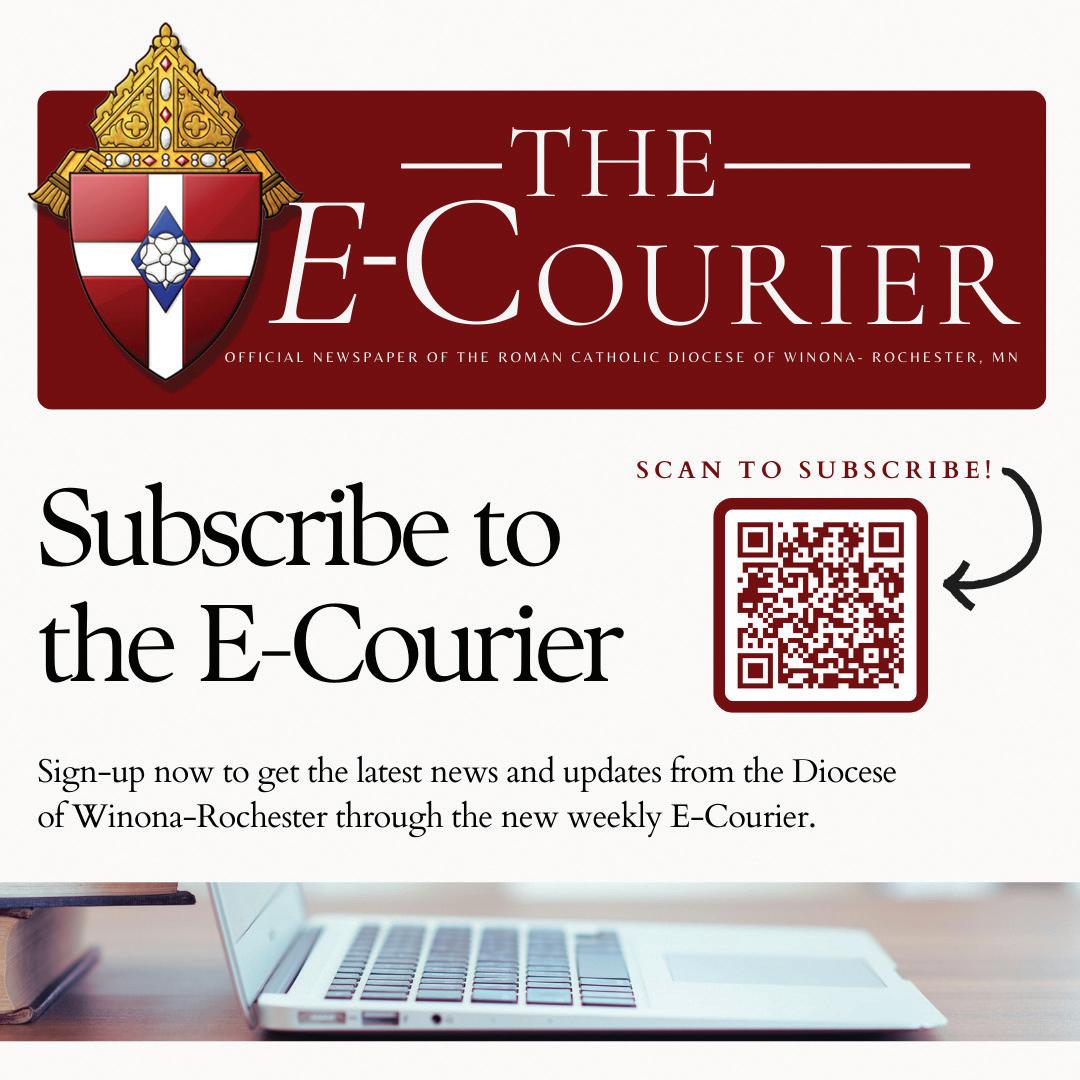
Olivia Anderson is a missionary with NET Ministries.
Visitors from Luxembourg
Dignitaries Tour DOW-R Catholic Sites and Communities of Luxembourgish Descent
By PAULA HARRIGAN and KRISTIN SPELTZ
�
n June 14, 2025, Elba and Rollingstone welcomed Luxembourg Ambassador Nicole Bintner-Bakshian and Consul Frank Biever to their collective Luxembourgish historical communities. The ambassador's June 2025 tour marks the first regional visit by a sitting ambassador since 2013, when Ambassador Jean-Paul Senninger traveled to the region. Luxembourg dignitaries have consistently visited Minnesota, demonstrating the value of maintaining close ties between Minnesota and Luxembourg.
Ambassador Bintner’s June 2025 outreach program was notable for not only its fiveday duration but also the scope of visits and the organizations and outreach engagements covered. Prior to arriving in Elba and Rollingstone, Ambassador Bintner, in partnership with Global Minnesota and the Minnesota Fulbright Chapter, presented to a large group of Minneapolis Luxembourg enthusiasts Wednesday, June 11, at the American Swedish Institute.
On Tuesday, June 12, Ambassador Bintner met with Ameriprise Financial senior leadership, toured the Minneapolis Institute of Art, meet with Secretary of State Steve Simon, visited the University of St. Thomas' Special Collections Department and toured the 3M Innovation Center.
Assisi Heights and Winona
On Friday, June 13, Ambassador Bintner met with Rochester Mayor Kim Norton followed by an extensive tour of Assisi Heights hosted by key leadership members of the Franciscan Sisters. The Mayo Clinic also provided a campus tour and presentation on Mayo’s Bold. Forward. Unbound. vision featuring a narrative of the Mayo Clinic’s

plans for the delivery of healthcare well into the 21st century. The delegation concluded Rochester activities touring Calvary Cemetery, the final resting place of the dedicated Rochesterbased Franciscan Sisters, many of whom were of Luxembourgish decent. It is also the final resting place of Mother Alfred Moes, Luxembourg’s most notable immigrant, credited as the foundress of the Sisters of St. Francis of Rochester and St. Mary’s Hospital, forming the basis of the Mayo Clinic as we know it today.
The delegation moved on to Winona where they were hosted by Bob and Marlene Kohner to a family celebration overlooking the Mississippi River. On Saturday, June 14, the Ambassador was guided on a world class tour detailing the impact Luxembourgish settlers had on Winona County, seeing first-hand how these communities continue to honor and celebrate their Luxembourg heritage to this day.
The Nicholas Marnach House
The Ambassador’s June 14 visit began with a tour of the Nicholas Marnach House located near Elba. Elba, founded in 1856, was primarily built by Luxembourg immigrants. Nearby, in Whitewater Township, the Nicholas Marnach House, built between 1857 and 1860, stands as the oldest stone structure in Southeast Minnesota. Constructed by farmers and stonemasons John and Nicholas Marnach (originally from Rambrouch, Luxembourg) the house was built in a traditional Luxembourg style.
In 1949, the Marnach House was acquired by the Minnesota Department of Natural Resources (DNR) when the state purchased the surrounding land for the Whitewater Wildlife Management Area. At that time, the house was unoccupied and deteriorating, but interest in its preservation remained strong.
In 1978 the Marnach House was placed on the National Historic Registry leading to the 1991-1993 restoration. The restoration brought numerous local Luxembourgish descendants together along with transatlantic Luxembourgish artisans. The Luxembourg government also played a critical role in completing this first substantial restoration. The restoration culminated in a 1993 celebration that included a Catholic Mass and cultural festivities.
The Marnach House remains owned by the Minnesota DNR, and the local Elba Heritage Society retains lease site access. Long term Elba Heritage Society members, notably Nancy Roberts, Marilyn Kopselle, Tom Ross (great grandson of Nicholas Marnach), Diane Rinn and Sally Letner, have provided years of tireless volunteer support. These volunteers not only provide the maintenance, cleaning and extensive caretaking needs a 165-year-old structure requires, but also market and operate numerous public open house events and privately scheduled
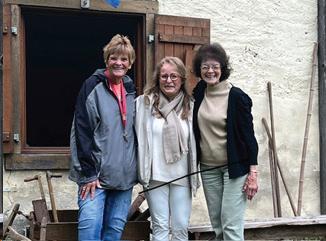
local and international student tours.
In addition to the local Elba Society’s welcoming of Ambassador Bintner, key DNR leaders Christine Johnson and Gretchen Miller also attended the open house event. The DNR continues to support its long-term commitment to sustaining the Marnach House and partnering with the Elba Historical Society. It is well understood that the Marnach House is one of the most valuable Whitewater Management Area attractions visited by thousands of hikers, hunters, historians, students and nature enthusiasts year-round.
Rollingstone Luxembourg Heritage Museum
After concluding the Marnach House tour the delegation arrived in Rollingstone, where, after lunch at the locally famous Bonnie Rae's Cafe, they toured the Rollingstone Luxembourg Heritage Museum.
Rollingstone, established in 1855, quickly became a dominantly Luxembourgish Roman Catholic community, with nearly all residents speaking Letzebuergish until WWI.
The museum, built between 1899 and 1900, is housed in what was once the Rollingstone city hall, fire station and jail. In 1987, the building began housing a small museum. A nonprofit organization later took over and formed the Rollingstone Luxembourg Heritage Museum. The Museum was officially added to the National Register of Historic Places in April of 2021 and showcases thousands of artifacts connected to Luxembourgish immigrants.

Ambassador Nicole Bintner-Bakshian with a portrait of Mother Alfred Moes at Assisi Heights. Photo credit: Kristin Speltz.
L to R: Ambassador Nicole Bintner-Bakshian, Sarah Schuh, Steve Schuh and Linda Kriedermacher. Photo credit: Kellen Studios.
L to R: Marilyn Kopselle, Ambassador Nicole BintnerBakshian and Nancy Roberts at the Nicholas Manarch House. Photo credit: Kellen Studios

Displays cover themes such as Holy Trinity Catholic Church’s history and early church school life. Between 1989 and 1992, restoration efforts intensified, and the Grand Duchy of Luxembourg once again engaged in a substantial restoration partnership. The museum re-opened in June of 1992 and has been visited by the Hereditary Grand Duke Henri. Present-day museum leadership welcoming Ambassador Bintner and Consul Frank included Steve Schuh (president), Linda Kreidermacher (director) and many other local community members.
Countless
Rollingstone Holy Trinity Catholic Church
The group toured Holy Trinity Catholic Church, built by the Luxembourg immigrants in 1869.
Listed on the National Register of Historic Places in 1984, Holy Trinity Catholic Church is recognized for its Gothic Revival architecture. The original church, constructed of local limestone, was designed and built by Charles Wender, a local builder in Rollingstone. The 1893 expansion, which doubled seating capacity and added a transept chancel to create a cruciform plan, was carried out by Nicholas Arnoldy, also a local craftsman.
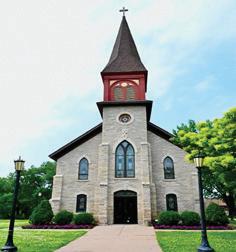
Holy Trinity Cemetery Trustee Mark Schmit provided a guided tour of the entire cemetery. The cemetery includes an open-air altar and headstone markers date back to the 1860s. Today, Holy Trinity Cemetery contains more than 650 marked graves, with some estimates exceeding 1,000 memorial entries recorded by genealogical platforms. The cemetery is heavily populated with Luxembourgish surnames, including Arnoldy, Lehnertz, Majerus, Stoos, Schmit and Speltz. The cemetery remains active with burials continuing to this day and stands as a testament to Rollingstone’s strong Luxembourgish Catholic heritage.
courageous Luxembourg ancestors established families, schools, churches and businesses, all built on sacrifice and faith.
The tour was led by Steven Speltz, a lifelong Rollingstone resident and Holy Trinity parishioner, and a master woodworking craftsman. Steve created the woodwork features completed during Holy Trinity’s most recent renovations, and his guided narrative brought an authentic historical context to the tour for the Luxembourg dignitaries.
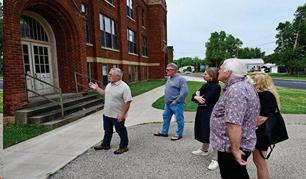
Holy Trinity School
In 1891, the Milwaukee Province Franciscan Sisters arrived to administer what ultimately became Holy Trinity School. The dedicated school building was constructed in 1920 under the direction of Father Anthony Hennekes. Holy Trinity School served Rollingstone’s Catholic youth for 47 years, with the Sisters of Saint Francis, Rochester, taking over in 1922. The school, under the leadership of Holy Trinity Catholic Church, ceased operation in 1967. In 2018, District 861 School Board voted to close Rollingstone Elementary, thus ending a 51-year relationship with District 861. Discussions remain ongoing regarding the ultimate disposition of the building. A potential redevelopment as apartments and community space remains active. The local community remains committed to preserving the schools’ historic and unique exterior.
Ambassador Bintner and Consul Biever returned to Minneapolis June 15 for one final event to celebrate Lëzebuerger Nationalfeierdag. Luxembourgers from across the Twin Cities metro and beyond gathered on the rooftop balcony of France 44 to share in good food, drink and comradery. Ambassador Bitner-Bakshian
provided closing remarks, leaving all those who were able to meet with her hoping for a return visit.
Countless courageous Luxembourg ancestors established families, schools, churches and businesses, all built on sacrifice and faith. They carved a life throughout Minnesota and beyond. Their many descendants, including local and international visitors, enjoy the fruits of these efforts to this day. Through the sustained connection with the Grand Duchy, Ambassador Bintner’s visit allowed everyone to revisit the themes of courage, faith, hard work and sacrifice, themes that never get old. These common themes continue to bind us all together, something needed in the everchanging fast passed world we live in today.
For the Catholic faithful of Rollingstone, the Ambassador’s visit was a welcome reminder of the profound history they hold, and an opportunity to revisit its significance. Our Catholic faith is so intertwined with the history of the establishment of this community in Rollingstone that the Church steeple towers above the town as a reminder of the sacrifices and faith of those who carved a life out of the wild rolling hills of this scenic valley. Daily the blessed bells of the Holy Trinity Catholic Church steeple ring out the call to pray the Angelus at noon and six in the evening, reminding all of the blessings that have come from God and the greatest of these is his incarnation, death and resurrection which brings us hope. The visit from Ambassador Bintner and Consul Biever is a poignant opportunity to stop and reflect upon the good people of 19th century Rollingstone and the many gifts they have brought to their posterity and neighbors.
Paula Harrigan is the secretary for Holy Trinity Parish in Rollingstone.
Kristin Speltz is an honorary consul of Luxembourg.
Would you like to share your parish history or events? Contact Nick Reller at nreller@dowr.org.

Holy Trinity Catholic Cemetery
Holy Trinity Church. Photo credit: Kellen Studios.
L to R: Consul Frank Biever, Tim Kohner, Ambassador Nicole Bintner-Bakshian, Honorary Consul Kristin Speltz, Mark Schmit, Rollingstone Museum President Steve Schuh, Fr. John J. Abts, Sarah Schuh and Carolyn Bagniewski in Holy Trinity Cemetery. Photo credit: Kellen Studios
L to R: Mark Schmit, Tim Kohner, Kristin Speltz, Steve Schuh and Sarah Schuh at the former Holy Trinity School. Photo credit: Kellen Studios
Our Lady of Luxembourg, inside Holy Trinity Church. Photo credit: Nick Reller, The Courier
A Catholic Tour of Southern Minnesota
By ELIZABETH WILLIAMS
Grace
in the Landscape, Light in the Parishes
Over the summer, I’ve had the privilege of traveling across southern Minnesota - visiting parish communities, listening to local leaders, and witnessing firsthand the vibrant faith that animates our corner of the world. What began as a tour in my role as executive director of the Catholic Foundation has evolved into a pilgrimage - one marked by hospitality, beauty, and the quiet power of renewal.
Each stop has offered something sacred. When I spoke with Anna Therneau, director of lifelong faith formation at the Cathedral of the Sacred Heart in Winona, I was struck by her genuine passion and the way parishioners have rallied around their full family faith formation program. A case study - really! When one more thing is hard to add to a growing to-do list for young families, Anna helps offer respite in a family setting for faith formation where dinner is served, lessons are shared together and day care provided for the littlests when needed. Their commitment is a reminder that evangelization isn’t just a lofty goal - it’s a living reality when rooted in relationship and sustained by faith.
At St. Mary's University, during a diocesan-wide gathering of Ministry Days, I joined a mid-week


Mass. The chapel was simple and beautiful; the silence was thick with meaning. Local leaders of all ages and walks of life sat in the rows ahead of me. Vicar General Father Will Thompson encouraged us that today was a day to pour into all of those who pour into so many others throughout the rest of the year. It reminded me of something Pope Francis once said: “The Eucharist is not a prize for the perfect but a medicine for the weak.” How humbling it is to see ordinary holiness unfold in quiet corners.
And then there’s the land. Southern Minnesota offers a contemplative landscape that speaks to God's artistry - a rolling canvas of fields, lakes, and sky. Driving between parishes, I’ve found myself captivated by it all. The golden light near dusk in St. Peter, the perfect bright blue sky with wisps of white over the rolling hills as I made my way through St. Charles, Houston and especially the drive along the Mississippi river. Each moment was an invitation to praise. It’s no wonder so many rural parishes have built outdoor grottos and prayer walks. (Check out St. Johns of Johnsburg.) Nature here isn’t just scenery - it’s sanctuary.
One of the most moving encounters came in St. Felix's of Wabasha, where I've met several times with a group of elders who have quietly sustained their parish for decades. Through stewardship, prayer, and mentorship, they care about a culture of intergenerational belonging. Their stories, from

back when there used to be functioning lights in the church shrines to the restoration of their century-old stained glass, embody what it means to be faithful stewards of both legacy and mission.
In conversations with pastors, volunteers, and lay leaders, I’ve seen a common theme emerge: people want to build something that lasts - not for their own glory, but for God’s. Whether it's a new catechetical initiative, a capital campaign, or a modest endowment, there's a spirit of intentionality at work. This is why the mission of the Catholic Foundation is so vital: to support your communities as they dream boldly and plan wisely.
More than once, I’ve left a parish with an unplanned free meal, a hug or a story of faith and passion. These small gestures carry great weight. They speak to the warmth of Catholic hospitality and the depth of shared mission. Our work isn’t transactional - it’s transformational, because it’s built on trust.
As I look ahead to the rest of this tour, I do so with renewed hope. Our parishes are not simply surviving - they are cultivating fertile ground. The seeds being planted today will bear fruit for generations to come.
And for those of us entrusted with the care of these communities - from development staff to pastors to donors - may we continue to walk humbly, dream generously, and steward faithfully.
Southern Minnesota, you’ve shown me what quiet excellence looks like. The road ahead is bright. Enjoy a sampling of some of the photographs. I only wish I could capture God's beauty as well as the eyes do.
Elizabeth Williams is the executive director of the Catholic Foundation of Southern Minnesota.

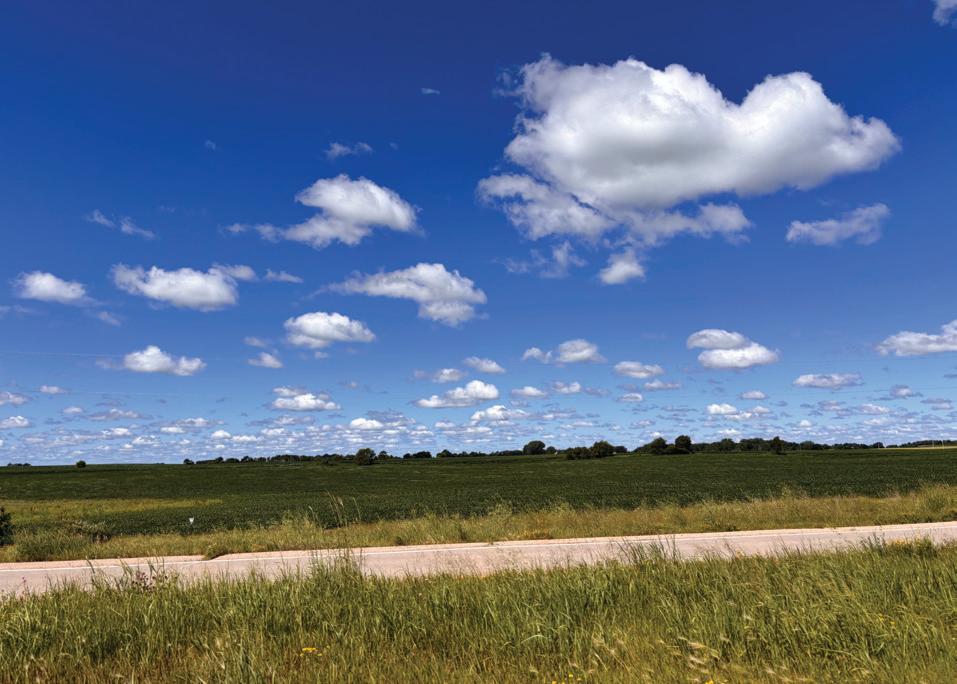
What Is a Parish Stewardship Committee, Do I Need One & How to Get Started?
By ELIZABETH WILLIAMS
What Is Stewardship?
The Catholic Church defines stewardship as a way of life rooted in discipleship - a grateful response to God’s unconditional love. It’s not just about giving; it’s about how we live, recognizing that everything we have and everything we are is a gift from God.
Do We Need a Stewardship Committee?
Many parishes have a local stewardship committee to help create a culture of gratitude, generosity, and active participation in the parish & community. A stewardship committee in a Catholic parish brings a host of spiritual, communal, and practical benefits. It’s not just a group—it’s a catalyst for transformation. Stewardship committees help with many things such as:
Spiritual Enrichment
• Deepens Discipleship: Encourages parishioners to live as grateful stewards, recognizing all gifts as coming from God.
• Fosters Conversion of Heart: Promotes a shift from obligation to joyful generosity.
• Integrates Faith and Action: Helps parishioners connect Sunday worship with everyday life through service and giving.
Community Engagement
• Builds Parish Vitality: Invites broader participation in ministries, events, and outreach.
• Strengthens Relationships: Creates opportunities for parishioners to connect through shared service.
• Welcomes New Members: Supports hospitality efforts that help newcomers feel at home and get involved.
Organizational Growth
• Supports Ministry Coordination: Maintains a catalog of parish ministries and helps match parishioners with opportunities.
• Improves Volunteer Management: Tracks involvement and ensures follow-up so volunteers feel valued and engaged.

• Provides Strategic Planning: Develops annual stewardship calendars aligned with liturgical seasons and parish goals.
Communication & Formation
• Educates on Stewardship Principles: Offers workshops, reflections, and lay witness talks to deepen understanding.
• Promotes Transparency: Shares annual reports and impact stories to build trust and accountability.
• Encourages Ongoing Formation: Helps parish leaders and members grow in their spiritual and practical understanding of stewardship.
Sustainability & Legacy
• Cultivates Long-Term Giving: Encourages planned giving, endowments, and legacy stewardship.
• Supports Financial Health: Coordinates time, talent, and treasure campaigns that sustain parish operations without reducing stewardship to fundraising.
Ideas for Stewardship through
the Seasons
Stewardship isn't easy to just turn on and off. It's not a water hose. It must be cultivated in a parish over time. If you're looking to start a committee at your parish, we've got a host of ideas to get you started in the coming year. Wherever you may be on your parish's stewardship journey, here's a place to start.
Summer Theme: "Living Stewardship Daily" Service & Sustainability Ideas:
• Parish Garden or Outdoor Project: Invite families to help beautify parish grounds or maintain a Marian grotto.
• Sunday Lunch Program Support: Coordinate volunteers or donations for outreach ministries.
• Stewardship Committee Retreat: Reflect on the past year, set goals, and pray together for guidance
• Bulletin Series: Everyday Stewardship: Share practical tips for living stewardship in daily lifehealth, relationships, finances, etc.
Fall Theme: “Grateful Hearts, Generous Lives” Gratitude & Renewal Ideas:
• Kickoff Reflection Series: Host short reflections after Mass or in bulletins on stewardship as a response to God’s gifts.
Congratulations to the following parishes, which have met their goals for the 2025 CMA since our last printing! Every dollar given beyond the parish’s goal is returned to the parish to address local needs!
• Annual Commitment Weekend: Distribute time, talent, and treasure commitment cards. Include testimonials from parishioners.
• Ministry Fair: Showcase parish ministries with tables and sign-up sheets to encourage involvement.
• Thanksgiving Outreach: Organize a parish-wide service project or collection for local families in need.
Winter Theme: “Stewards of Faith & Community” Formation & Fellowship Ideas:
• Stewardship Speaker Series: Invite guest speakers or parish leaders to share on topics like spiritual stewardship, financial wellness, or Catholic social teaching.
• New Parishioner Welcome Event: Stewardship committee helps host a gathering to connect newcomers with parish life.
• Christmas Gratitude Campaign: Send handwritten notes or small tokens of appreciation to volunteers and donors.
• Annual Report & Reflection: Share a visual summary of stewardship impact - ministries supported, outreach accomplished, etc.
Spring Theme: “Planting Seeds of Hope” Growth & Evangelism Ideas:
• Youth Stewardship Spotlight: Collaborate with the Knights of Columbus or Catholic Daughters to highlight youth service and promote the Stewardship Award.
• Lenten Stewardship Challenge: Encourage parishioners to offer time or talent in new ways - volunteering, prayer, or acts of mercy.
• Volunteer Appreciation Event: Host a simple brunch or reception to honor those who serve.
• Easter Stewardship Reflection: Share a message on resurrection and renewal as a call to deeper discipleship.
In short, a stewardship committee helps a parish live its mission more fully - spiritually, communally, and operationally. What will you do with this information? How can you inspire more stewardship in your parish and community?
Elizabeth Williams is the executive director of the Catholic Foundation of Southern Minnesota.
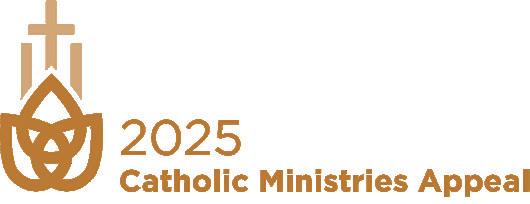
If you haven’t yet donated, we ask that you prayerfully consider God’s call and give your gift of time, talent, and treasure to support the Catholic Ministries Appeal.
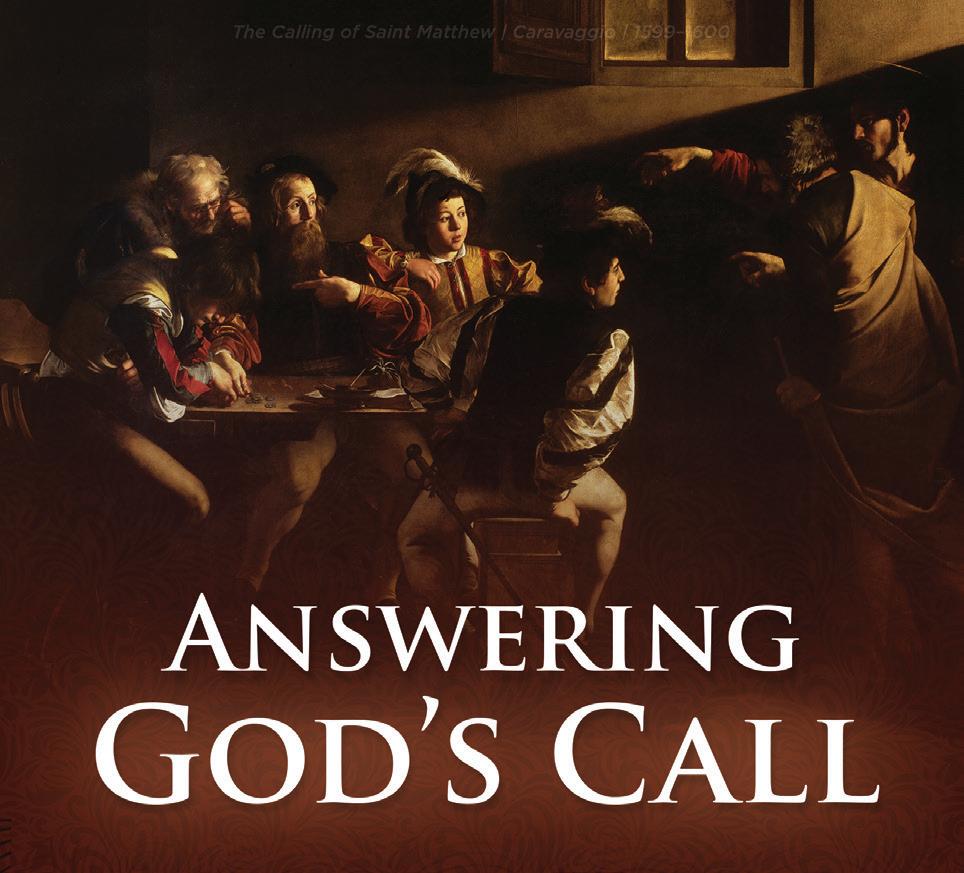
Catholics Heed the Call
By MINNESOTA CATHOLIC CONFERENCE
�
ope Leo recently echoed a phrase used by Pope Francis: “Politics is one of the highest forms of charity because it serves the common good.” When considering how to best love our neighbor, becoming a politician, or running for a local board or commission, is not likely at the top of our mind. But it is in these roles that we can live out the charge shared by our current and recent popes to help bring about the common good in our communities.
Surely entering political life can be messy and come with risks. Last month, Minnesota was shaken by political violence that raised sobering questions about the state of our public life. It reminds us that public service can demand extraordinary courage and sacrifice. In moments like this, it would be understandable to steer clear of entering public life. But in this moment, we need people of faith to step forward.
Separation of Church and State
One of the most persistent misunderstandings in our civic life is the idea that faith must be left behind when one enters public office. Some believe that the “separation of church and state” means religious conviction has no place in public decisionmaking.
As Pope Benedict XVI reminded the U.S. bishops during their 2012 ad limina visit, “the legitimate separation of Church and State cannot be taken to mean that the Church must be silent on certain issues …” It does not require people of faith to check their values at the door. Our laws and institutions have always been shaped by citizens bringing their moral convictions to the public square. As Archbishop Fulton Sheen said, “A religion that doesn’t interfere with the secular order will soon discover that the secular order will not refrain from interfering with it.”
The Cross
By DEACON ROBERT YERHOT, MSW
� will soon be turning 70 years of age. At the end of my seventh decade of life, I find myself thinking about how life has gone for me, the ups and the downs, the consolations and desolations of it all. What has become very evident is that, since my early twenties, I have personally known the Cross. I know what the Cross is like.
I have concluded that no one over the age of 20 is exempt. I have concluded the Cross is very real. How do we think about our crosses? What is our attitude toward them?
We run from the Cross. We hide our personal crosses so others cannot see, know, or recognize them in us. We want to get that cross off our backs as soon as we can.
Catholic social teaching gives us practical principles, such as caring for the poor, respecting life, and working for the good of everyone, that help shape just laws. Being a faithful Catholic in public office does not mean imposing beliefs; it means proposing ideas rooted in respect for life and care for the vulnerable.
Vocation of Public Service
These principles are desperately needed in our polarized political climate. When fear and division are on the rise, Catholics are called to be witnesses of hope, charity, and courage. Public service is not reserved for subject matter experts or career politicians. It is a vocation - a generous response to God’s call to love our neighbors and promote the common good.
If you have ever felt a stirring to serve in public life, this is a moment to prayerfully consider it. Our communities need leaders to step forward who will protect human dignity and promote policies that uphold life, strengthen families, and support those on the margins.
Discernment begins with honest reflection. Ask yourself: Is God inviting me to consider public office? Do I have the desire to serve, and the willingness to grow in virtue and perseverance?
If the answer is even a tentative yes, take a small step forward:
• Consider serving on a local board or state commission.
• Speak with a pastor or mentor about your interest.
• Reach out to the staff of the Minnesota Catholic Conference with questions or to learn more about the process of running for office.
August is the typical filing deadline for open seats in your communities, so now is a good time to start exploring this option.
Even if you are not called to run, you can play a vital role by supporting and encouraging faithful Catholics who do feel that call. Our communities and our state need leaders formed by conscience and guided by faith.
Join the Catholic Advocacy Network today at mncatholic.org/join/?recruiter_id=110508.
Be not afraid. Our world needs your light.
The Minnesota Catholic Conference has been the public policy voice of the Catholic Church in Minnesota since 1967. The voting members of the MCC's board of directors are Minnesota's Catholic bishops.
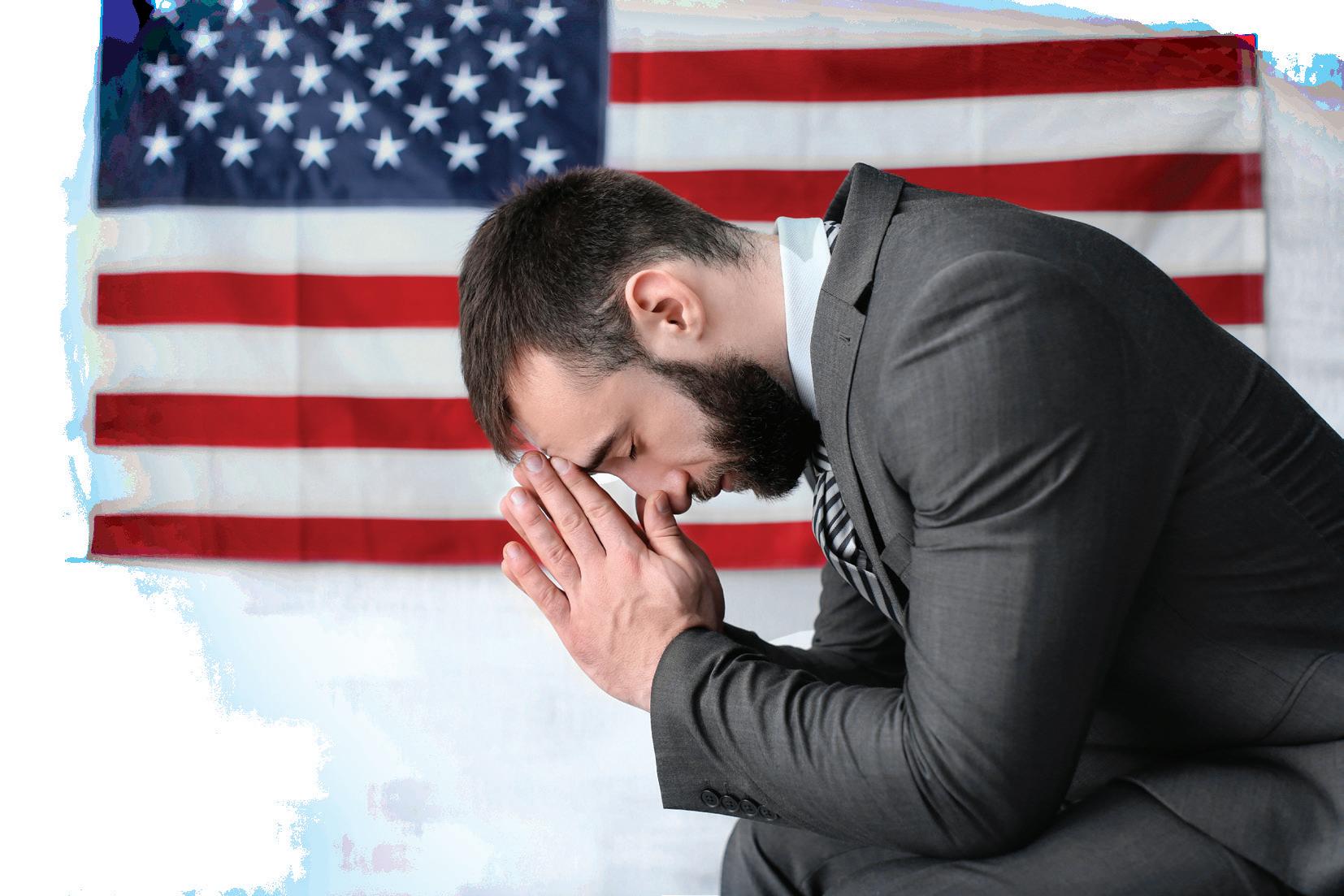
Each of us is carrying at least one cross. Each of us must find a way to see in that cross the very place where God most fully loves us. Each of us must begin to understand how it is in the cross we bear that God most clearly has loved us, poured out his love upon us. In the cross of your life, God is loving you most.
I have seen men care for their critically ill wives. Certainly, no man would want a critical illness for his wife, yet in that cross the love of a husband for his wife is most clearly seen. I have known parents who sacrificed all to save the lives of their children. That cross becomes the very place where parental love is most fully expressed.
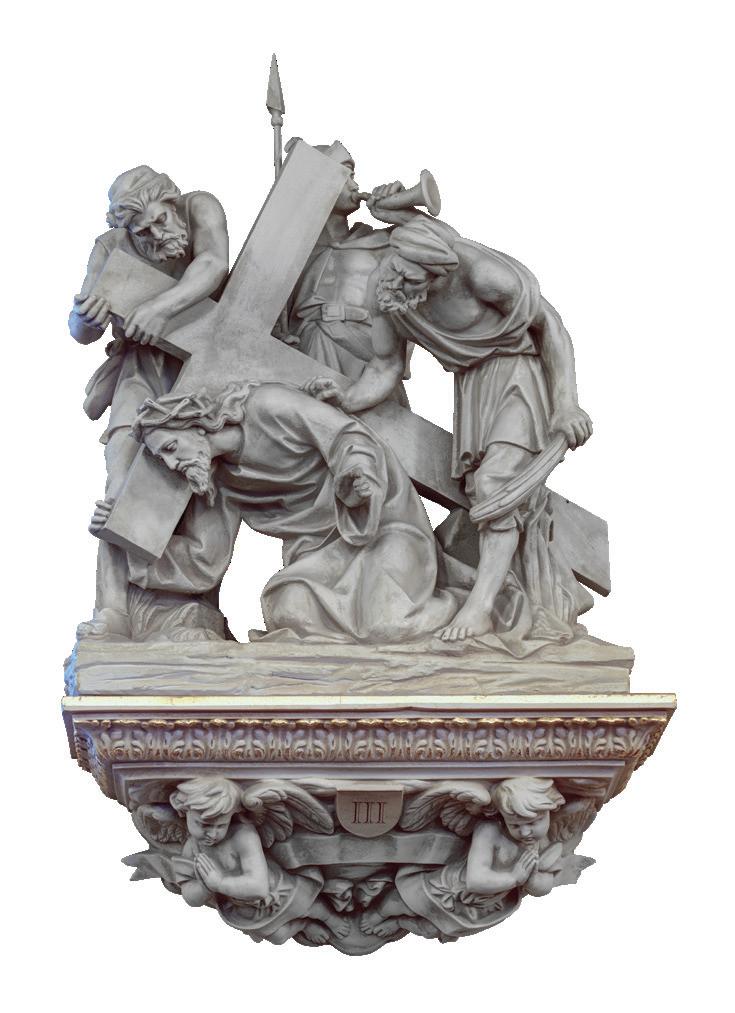
Too often we see the cross of our lives as an indication of the absence of God and his love. Too often the cross in our lives seems like a sign of God’s lack of concern for us.
I believe we must remember one thing: we cannot escape God’s love or his presence, no matter what has happened. We cannot escape the fact that, in the crosses of our lives, God has poured out into
us his love, more than perhaps at any other time or place in our lives. Indeed, our crosses were his before they became ours. Jesus Christ has carried them first. He knows everything about them.
We share in the Cross of Jesus. We carry his cross in our lives. We are very close to Jesus when we take up his cross, and he is very close to us. We are, in fact, walking cheek to cheek with him, and he with us. All of this requires faith. It makes no sense at all if you do not have faith. It is nonsense without faith.
I have known the crosses of the loss of loved ones, the loss of my wife, the loss of possessions, loss of health, being misunderstood and ridiculed, being rejected and unloved. I have known the crosses of fear, worry, loneliness, and confusion. I know these are the same crosses many of you bear. Will we in faith find in them the love of God poured out abundantly into our lives?
May God love you all!
Deacon Robert Yerhot, MSW, is the director of the diaconate for the Diocese of Winona-Rochester.
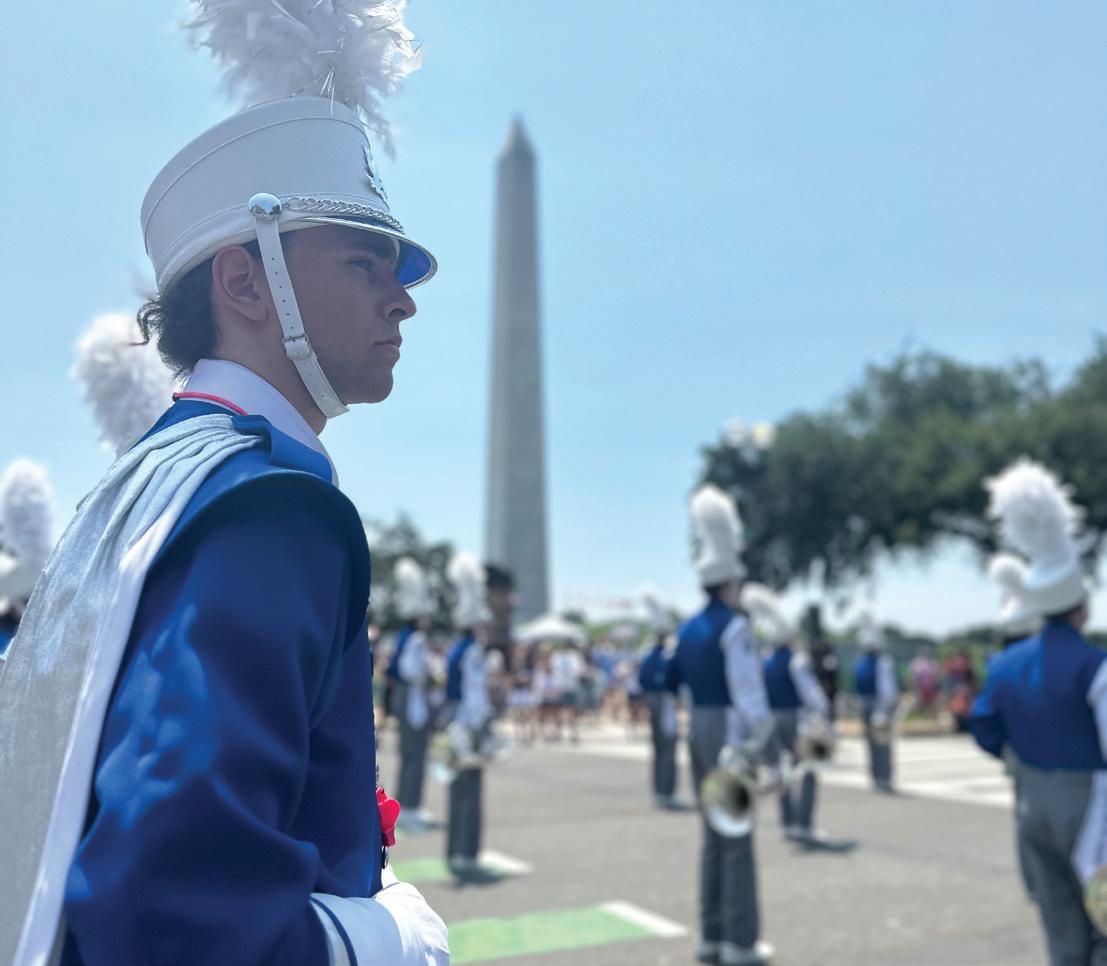
, part of Cotter Schools in
was given the honor of marching in America's National Independence Day Parade in our nation’s capitol on July 4.
Bands are invited based on nominations from the offices of elected officials from their state. Other times these recommendations come from a state’s music educators office or other music education organizations. Representation from all parts of the United States is the goal of the Parade National Selection Committee. Bands must submit a video recording, photos, and biographical information detailing experience, honors, past adjudication results, festival ratings, etc. The Cotter Marching Band was given an incredible honor in being selected this year.
During their time on the East Coast, the band was also able to tour a variety of places, one of which was the Basilica of the National Shrine of the Immaculate Conception in Washington D.C. They were able to spend some time in prayer there and then have dinner next door at the Catholic University of America.
Our Catholic schools provide incredible opportunities for students to explore and see our faith in the world!
Photo and caption by EMILY SMITHLEY, media specialist for the Diocese of Winona-Rochester.
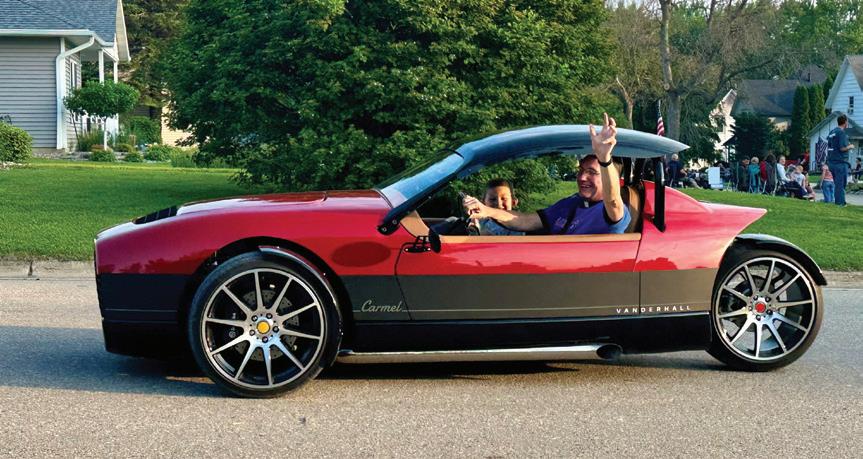

Obituary
Sister Faith Huppler, OSF, 95, a Franciscan Sister of the Congregation of Our Lady of Lourdes, Rochester, died at Assisi Heights on Wednesday, July 23, 2025.
Eileen Cecilia Huppler was born on February 11, 1930, in Watertown, SD, to Wallace and Anna (Roche) Huppler. She entered the Sisters of St. Francis in 1948, received the name of Sister Faith, and made perpetual vows in 1954. She received her Bachelor of Nursing from the College of St. Teresa, Winona, in 1954; a Master of Science in religious education from Fordham University, Bronx, NY, in 1970; and a Master of Arts in counseling psychology from Pacifica Graduate Institute, Carpinteria, CA, in 1991.
Sister Faith dedicated her life to service in various roles across the U.S. From 1951-65, she served as a nurse at St. Marys Hospital, Rochester. She then took on leadership roles at St. Francis Convalescent Home, Denver, CO, from 196566, before returning to Assisi Heights for convalescence from 1966-67. Sister Faith’s ministry expanded to parish work, including roles at St. Thomas Aquinas Parish, Ames, IA (1970-77), St. Theodore Parish, Albert Lea (1977-79), and St. Labre Indian Mission, Ashland, MT (1980-88). She later worked in healthcare
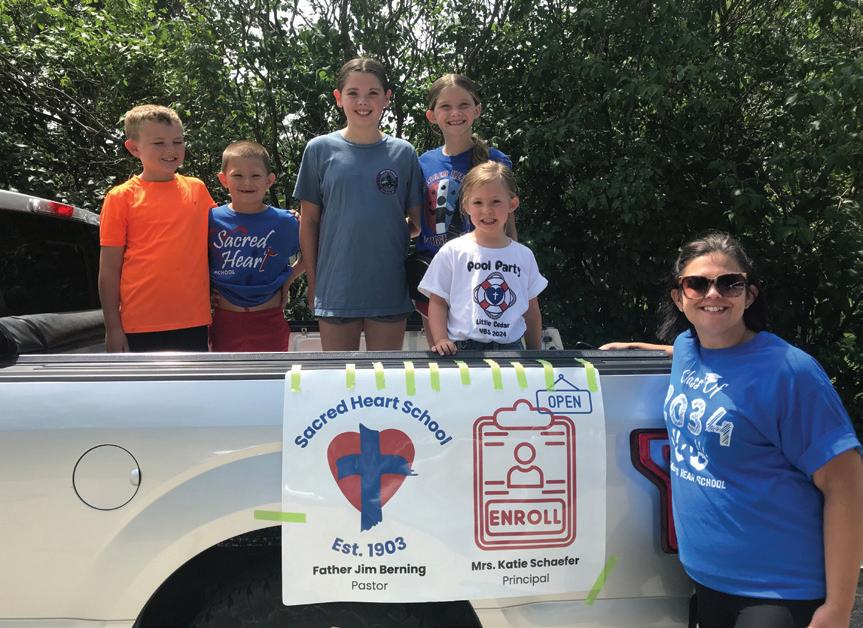
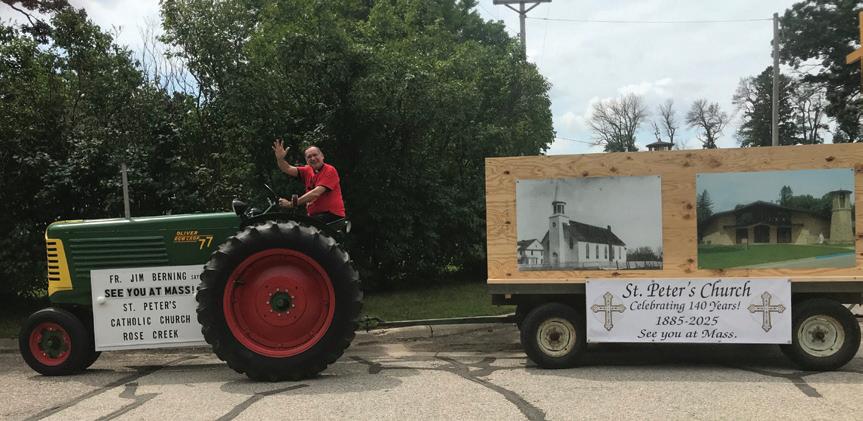
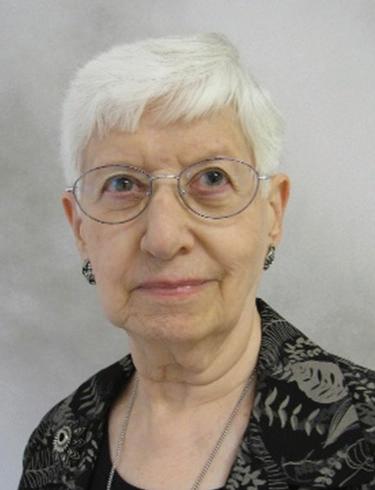
and counseling, including at UCSF AIDS Health Project and Mission Day Adult Treatment Center in San Francisco, CA (1989-93), followed by counseling positions in Bernalillo, NM (1993-97), and at St. Martin’s Hospitality Center in Albuquerque, NM (1993-2002). In 2002, Sister Faith retired to Assisi Heights, where she continued her ministry through choir and prayer. Her legacy is one of
compassionate service, faith, and healing.
Survivors of Sister Faith Huppler include her Franciscan Sisters, with whom she shared life for 77 years; and a sister, Kay Mikkelson. She was preceded in death by her parents; brother, Edward Huppler; and two sisters, Mary Lou Winzenburg, and Margaret McMillen.
A Resurrection Liturgy was held at Assisi Heights on Monday, July 28, 2025, followed by burial at Calvary Cemetery.
Online condolences are welcome at www. mackenfuneralhome.com
Memorials are suggested to the Sisters of St. Francis, Office of Mission Advancement, Assisi Heights, 1001 14th St. NW, Rochester, MN 55901.
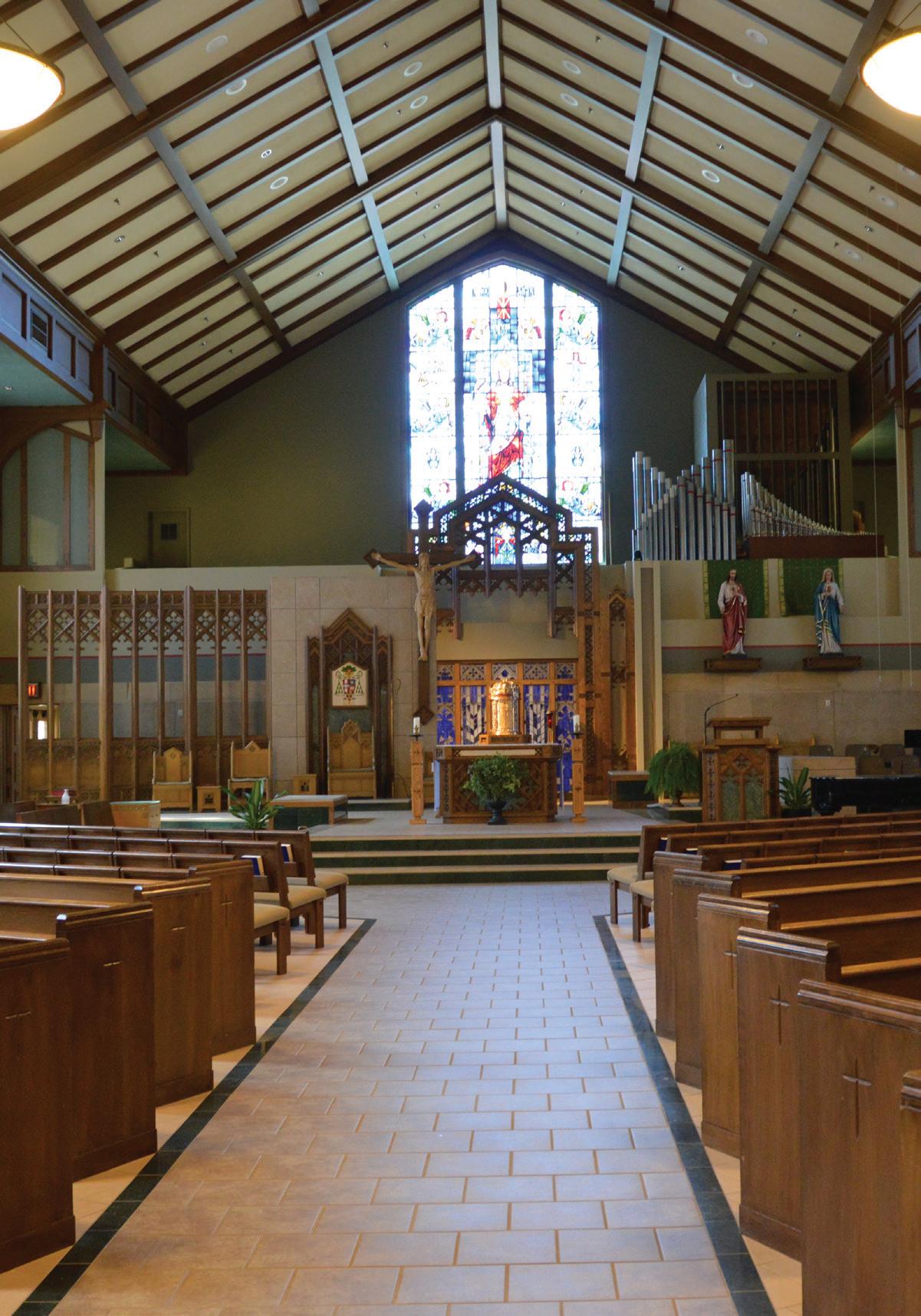
The Televised Mass Is Offered Every Sunday
Sioux Falls - ODLT Channel 7 at 7 a.m.
Sioux City - KPTH Channel 44 at 8:30 a.m.
Mankato - KEYC Channel 12 at 7:30 a.m.
Digital Channel 12.2 or Charter Channel 19 NEYC at 9:30 a.m.
Digital Channel 7 (DirecTV) or Channel 11 (DISH) KMNF at 9 a.m.
Rochester/Austin/Mason City KIMT Channel 3 at 7:30 a.m.
MyTV 3.2 at 9 a.m.
Twin Cities - WFTC Digital Channel 29 or Channel 9.2 at 11:30 a.m.
Southeastern MN - HBC Channel 20 at 3 p.m. (repeated Wed. at 3:30 p.m.)
Winona/La Crosse/Eau Claire - WLAX/WEUX Channel 25/48 at 7:30 a.m.
and on our website, dowr.org (click "Weekly Mass")

See y�u a� Ma��! - Fr. James Berning, pastor of Sacred Heart, Adams; St. Peter, Rose Creek; Queen of Peace, Lyle; and St. John, Johnsburg, took his evangelical message to the area parade circuit this summer in a variety of vehicles. These pictures were taken at Dairy Days in Adams on June 7 (top two), Lyle Independence Day Celebration on June 29 (bottom left), and Rose Creek Fun Days on July 12 (bottom right).
The C���er H��h S�h��l Mar�h�n� Ban�
Winona,

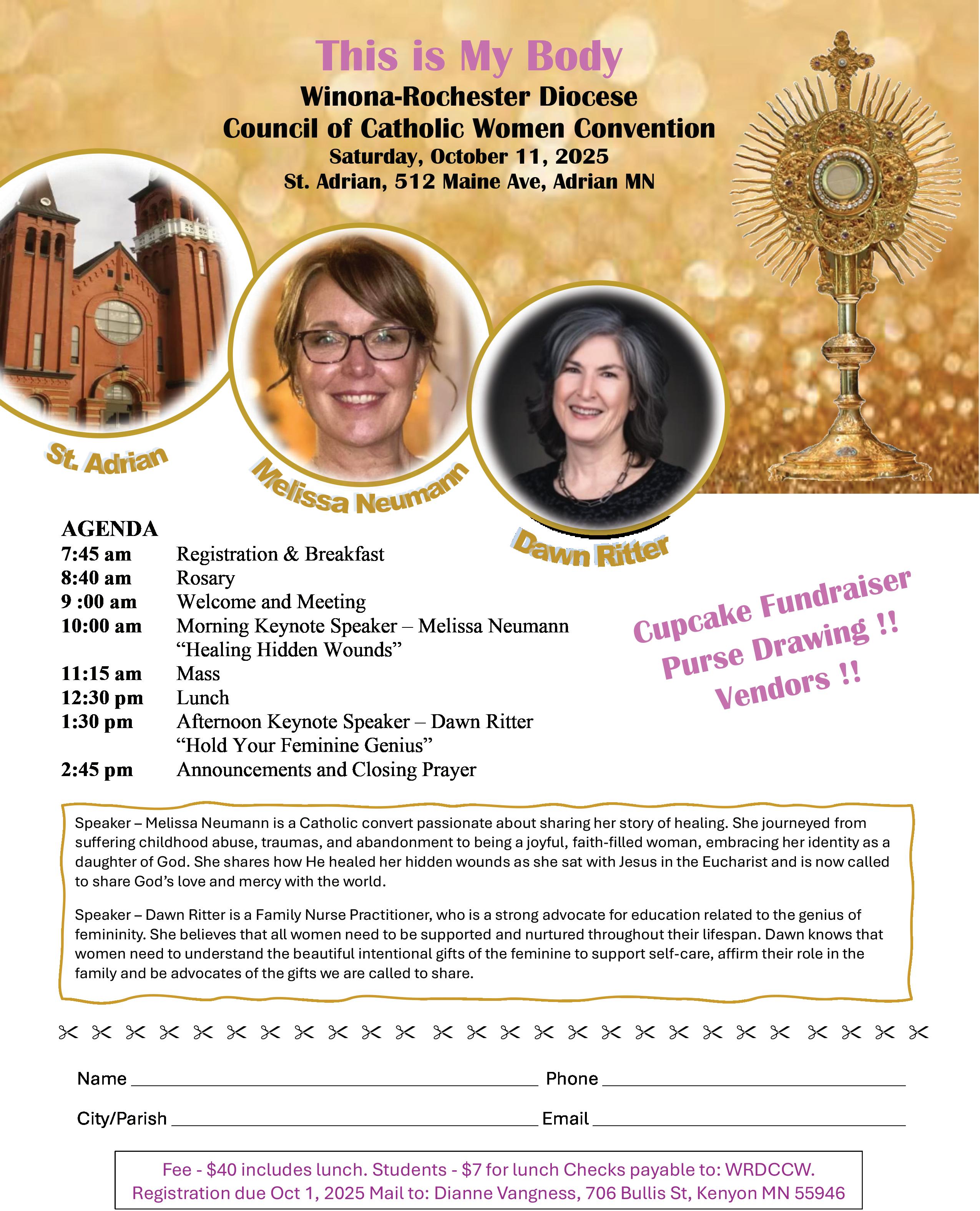
Parish Events
September 7, Sunday
St. Anthony Parish, Lismore, will hold its bazaar and craft auction at the church. Dinner served 11 a.m. to 1 p.m. Turkey dressing, mashed potatoes, glazed carrots, tea rolls, cranberries, assorted desserts and a beverage. Live auction starts at 1:30, with Big Ticket drawing after the auction. For auction are homemade crafts, home décor items, unprocessed hogs, pork and beef bundles and themed baskets. Baked Goods available at the Country Store. Games for kids and adults from 11:30 to 1:15. Nachos and beverages sold during the auction.
St. John the Baptist Parish, Johnsburg, will serve its fall dinner from 3:30-6:30 p.m. at the church. Turkey, ham, potatoes, gravy, dressing, green beans, bar. Drive through or dine in.
September 21, Sunday
St. John Baptist de la Salle Parish, Dodge Center, will serve its 32nd annual turkey dinner with all the fixings from 11 a.m. to 1 p.m. at the church. 20 2nd St. NE in Dodge Center. $15 adults. $6 kids 6-12. Free 5 & younger. $5 raffle tickets, Bingo, baked goods, produce, bucket drawings, quilts for sale. All tickets and take-out tickets sold at the door. Handicap accessible.
Ss. Peter & Paul, Mazeppa, will host their fall bazaar at the church. Ham & turkey dinner served 11 a.m. - 1:30 p.m. $15 per person. Raffle and Country Store also!
